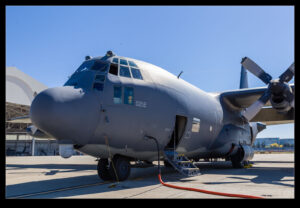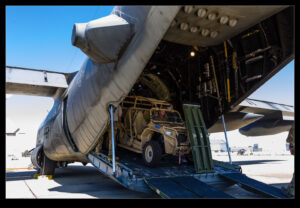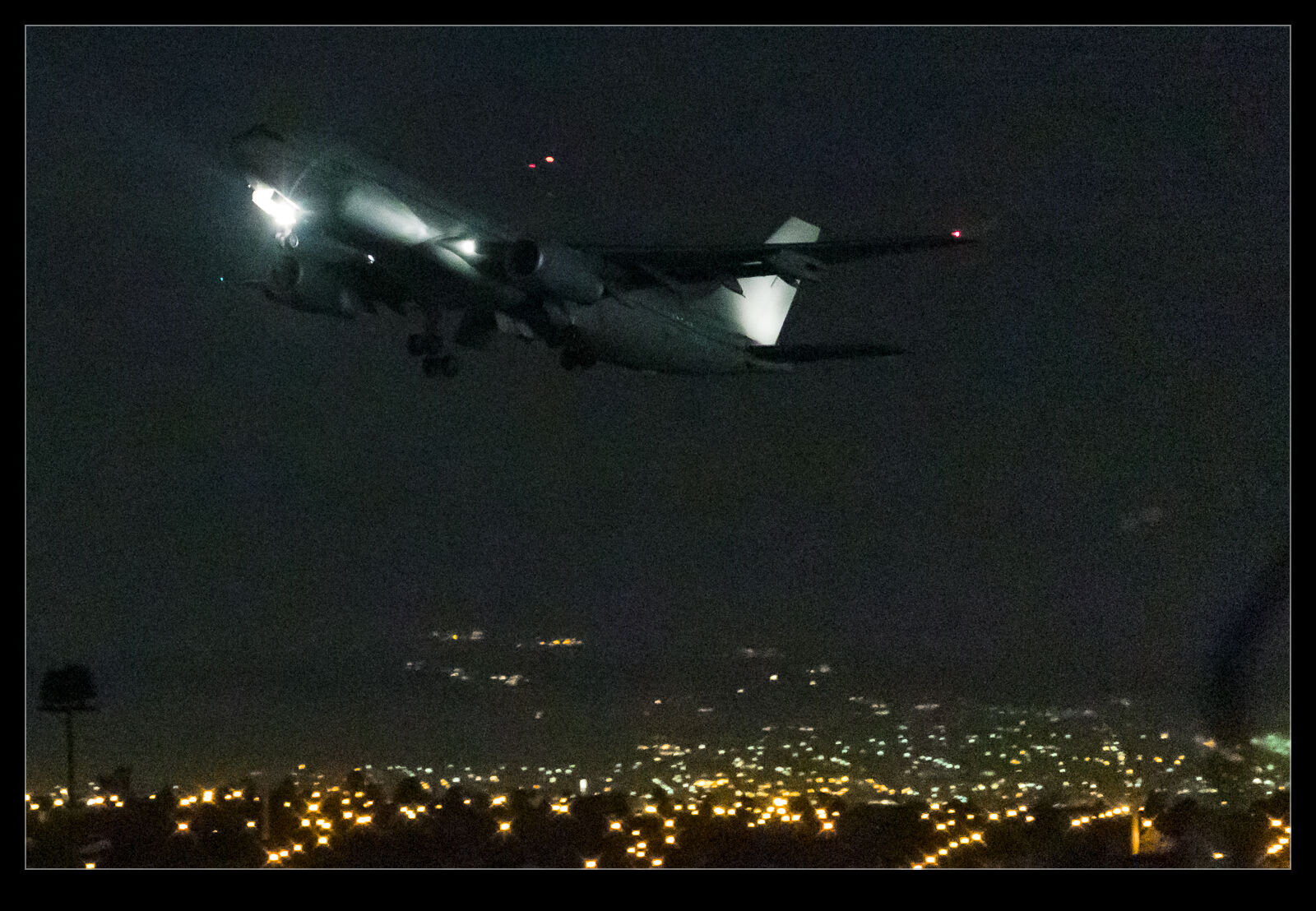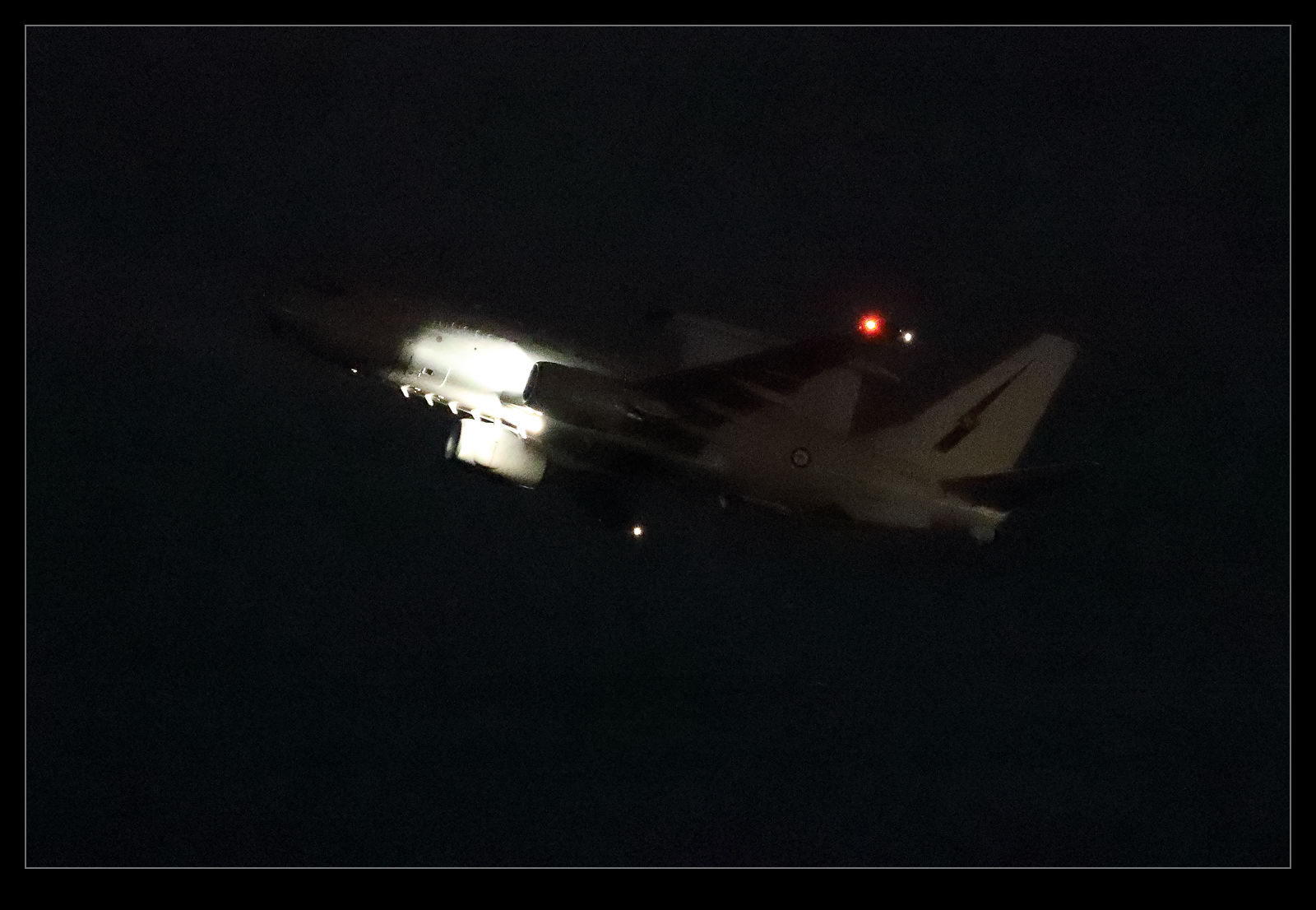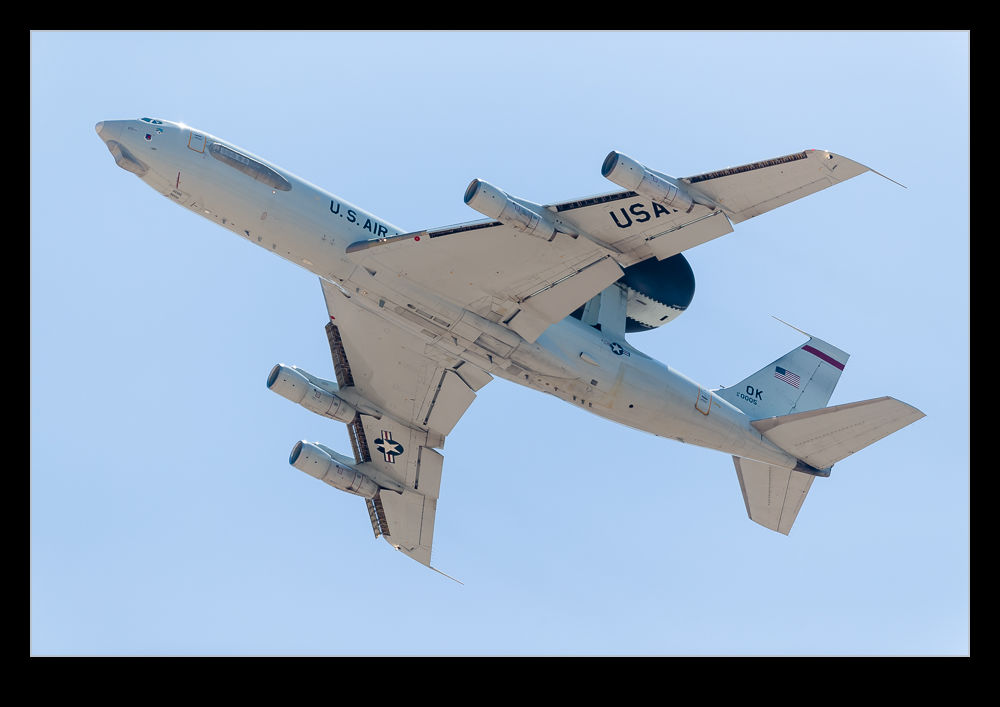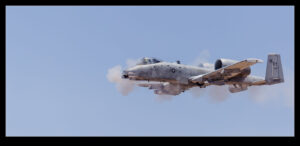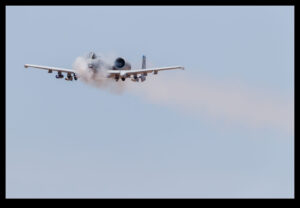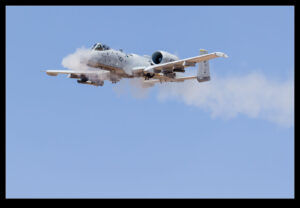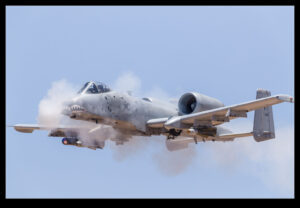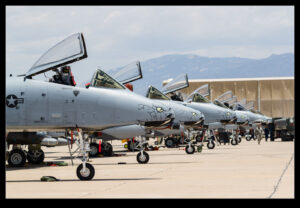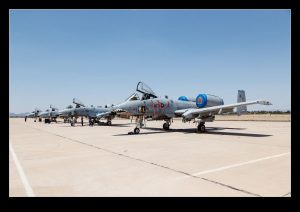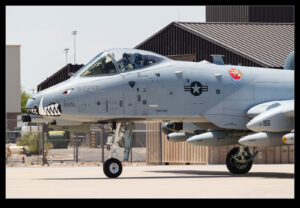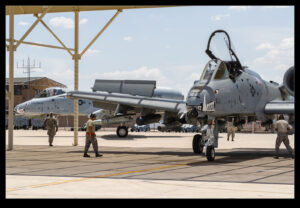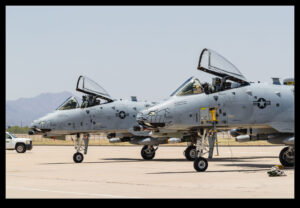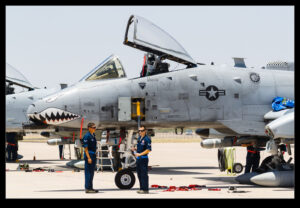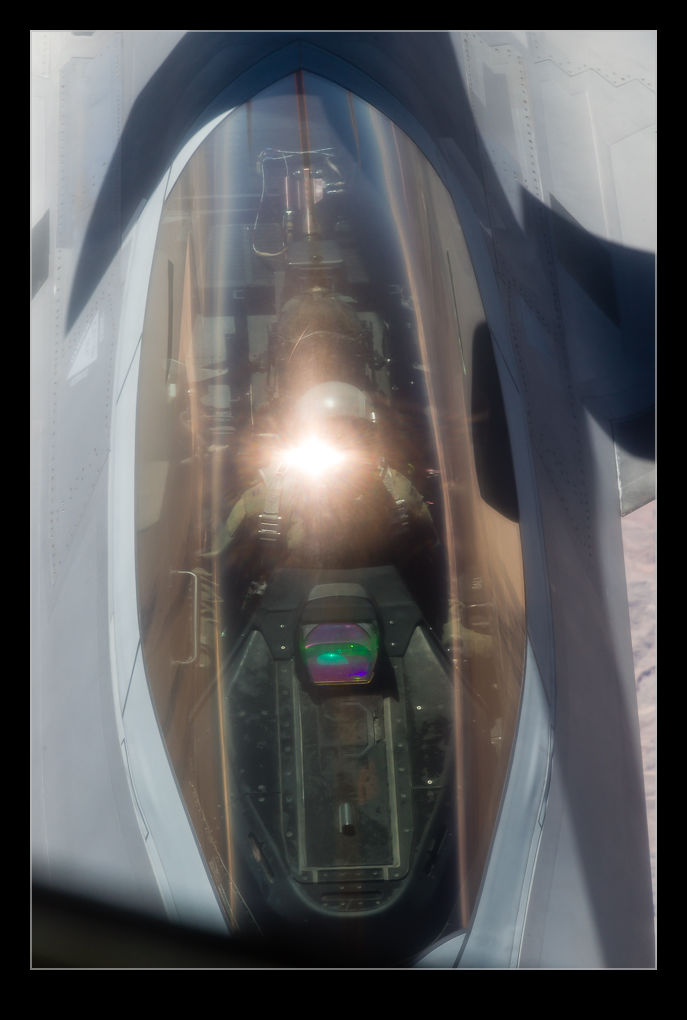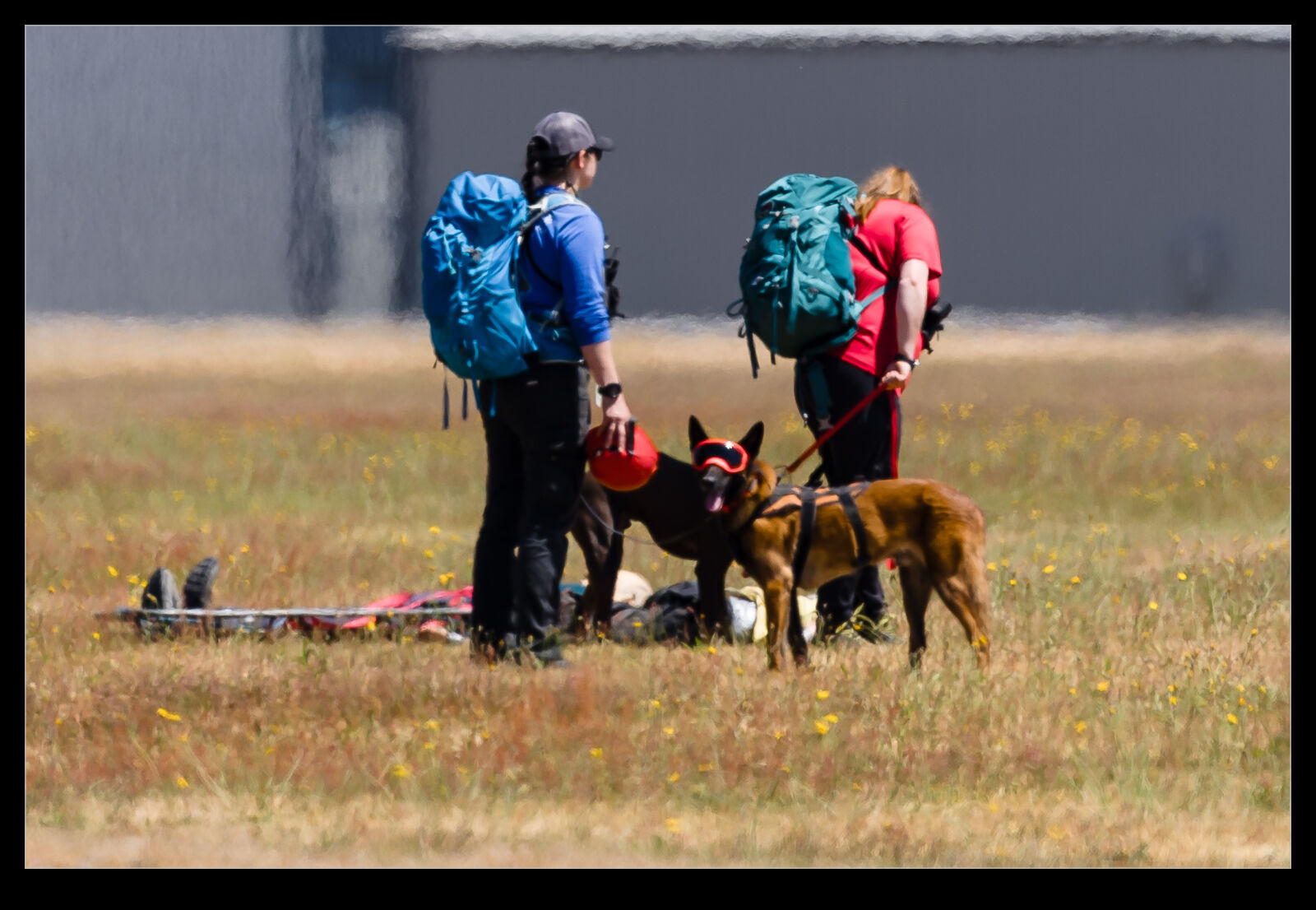 I was a bit far away from the action to get a good shot of this but, during the aviation exercise recently conducted between multiple agencies at Arlington, there were support teams for emergency requirements which included some dog teams. I saw the dog teams head to the helicopters to head out to one of the exercise locations and then return later. The dogs were wearing goggles to protect them while around the helicopters and airborne. I would love to have been a bit closer to get some better shots but sadly that wasn’t the case.
I was a bit far away from the action to get a good shot of this but, during the aviation exercise recently conducted between multiple agencies at Arlington, there were support teams for emergency requirements which included some dog teams. I saw the dog teams head to the helicopters to head out to one of the exercise locations and then return later. The dogs were wearing goggles to protect them while around the helicopters and airborne. I would love to have been a bit closer to get some better shots but sadly that wasn’t the case.
Tag Archives: exercise
MC-130 on Exercise
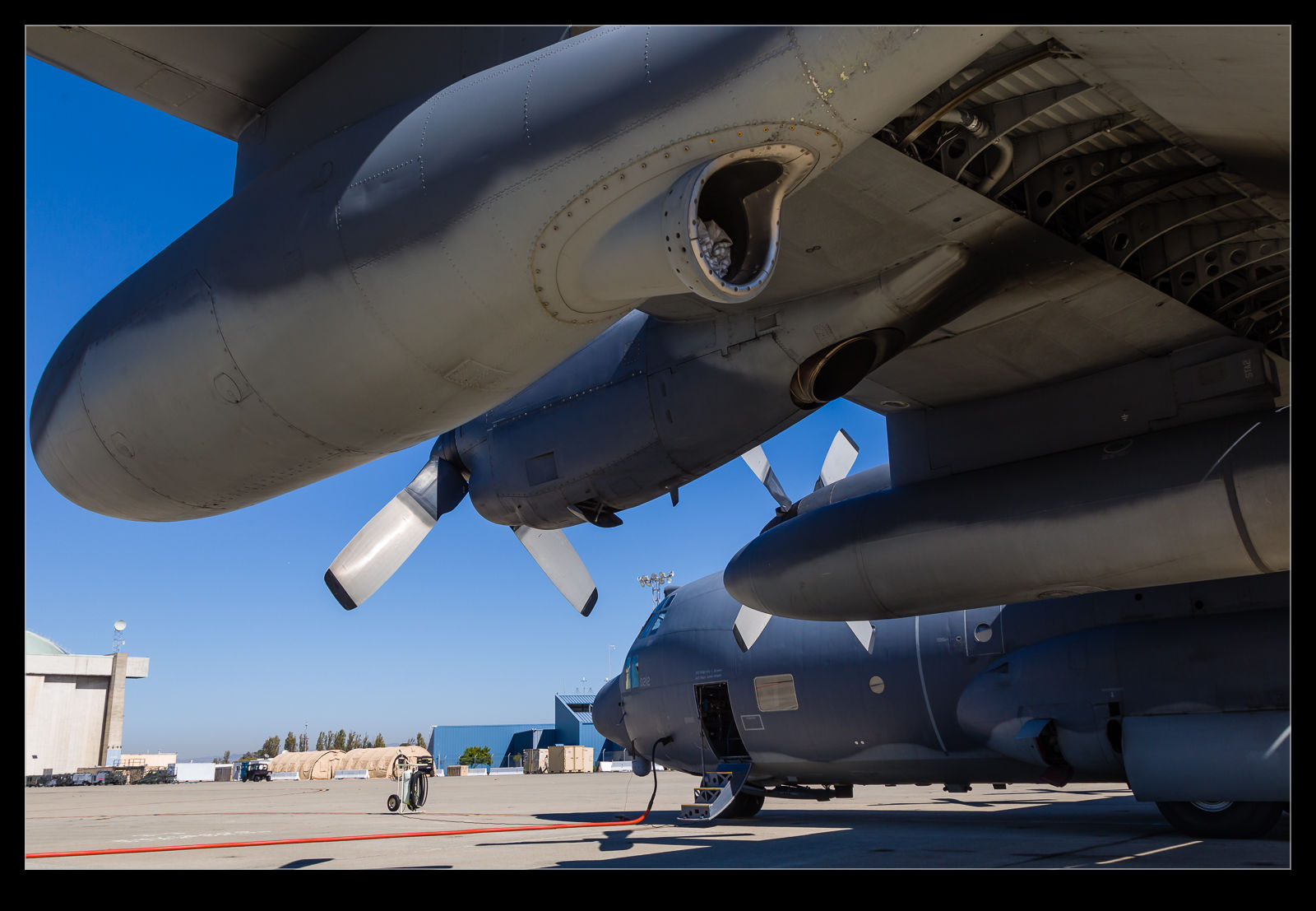 In this previous post about the hangars at Moffett Field, I mentioned that I was there to cover an exercise. The MC-130s were a big part of the exercise. They were loading up and launching down to remote landing strips on the California coast. The holds were full of equipment including off road vehicles. Loading these up was a tight fit. While the crews spent time getting everything ready to go, I was reasonably free to wander around the airframe and get some shots.
In this previous post about the hangars at Moffett Field, I mentioned that I was there to cover an exercise. The MC-130s were a big part of the exercise. They were loading up and launching down to remote landing strips on the California coast. The holds were full of equipment including off road vehicles. Loading these up was a tight fit. While the crews spent time getting everything ready to go, I was reasonably free to wander around the airframe and get some shots.
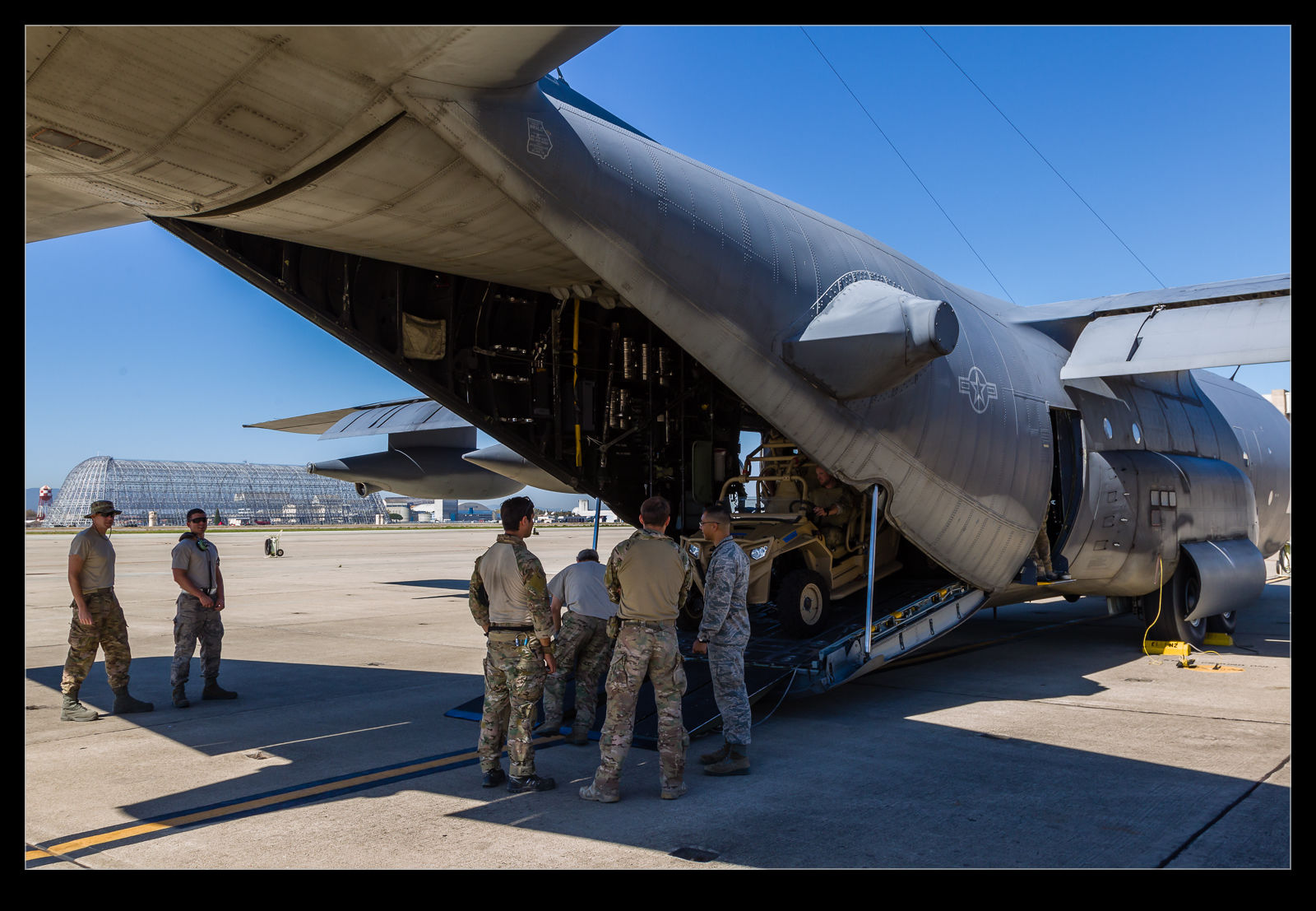 Here are some that I got that day. These were some of the oldest Combat Shadow (and maybe Hercules) airframes around at the time and I suspect that they have been replaced by now, I think by Combat King J models.
Here are some that I got that day. These were some of the oldest Combat Shadow (and maybe Hercules) airframes around at the time and I suspect that they have been replaced by now, I think by Combat King J models.
Missile Load Training
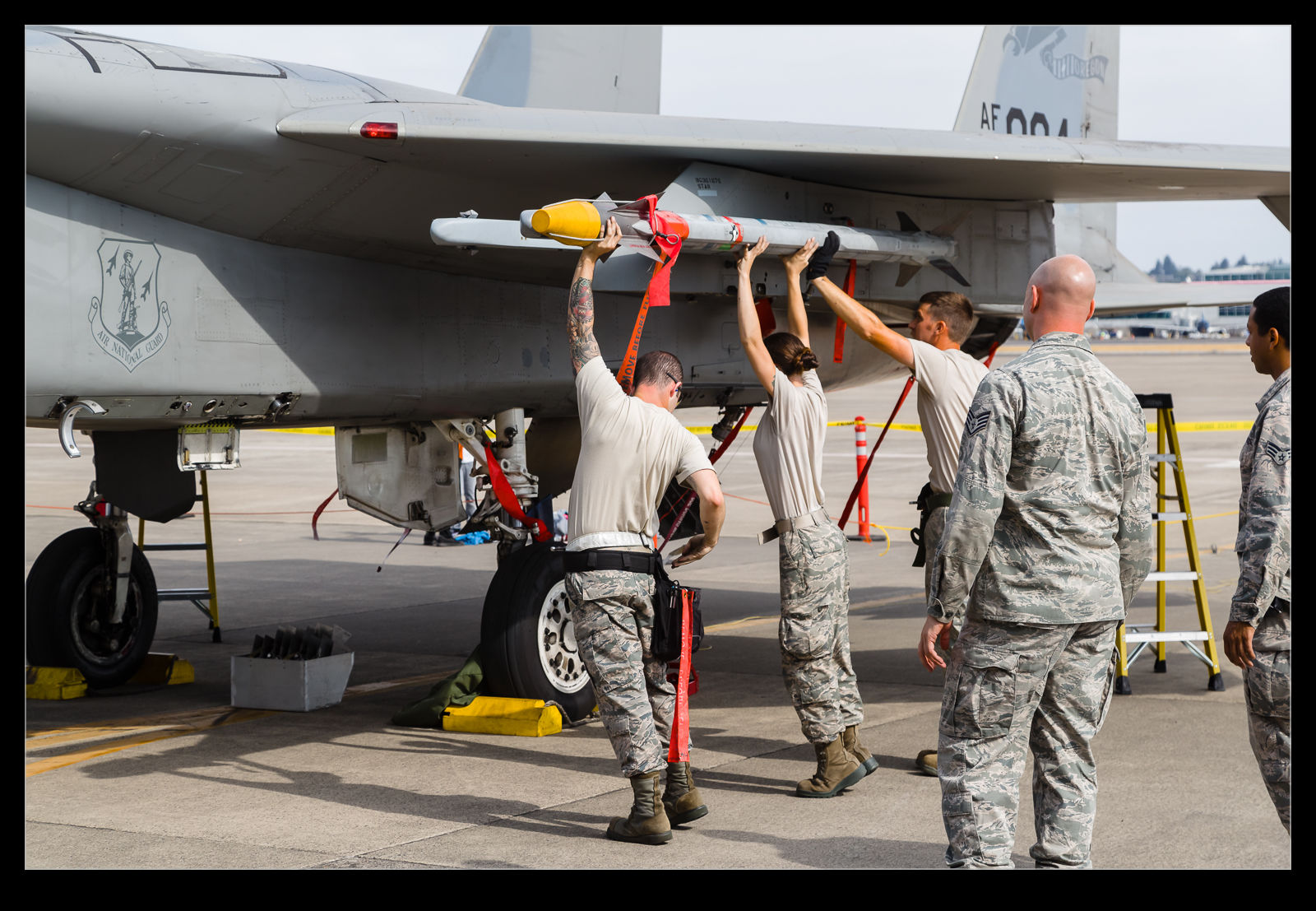 The open day at the Portland ANG base included a demonstration of missile loading. A jet had been parked out on the ramp for the morning and there was a rack of missiles also on display. Towards the end of the morning, a team started to prep the jet for loading. This was an exercise that had multiple purposes. It was a demonstration for the guests, but it was also a qualification test.
The open day at the Portland ANG base included a demonstration of missile loading. A jet had been parked out on the ramp for the morning and there was a rack of missiles also on display. Towards the end of the morning, a team started to prep the jet for loading. This was an exercise that had multiple purposes. It was a demonstration for the guests, but it was also a qualification test.
 Apparently, the crews are required to carry out a loading drill every 90 days when they are timed and observed in order to maintain their qualifications. Therefore, a pair of observers were there to watch the three-person team do their work. It can’t have been fun to have the public watching and the assessment team overseeing you at the same time. The crew got to it though and they seemed to be diligently following every procedure which is no bad thing when you are potentially dealing with live weapons (not that these examples were in any way live).
Apparently, the crews are required to carry out a loading drill every 90 days when they are timed and observed in order to maintain their qualifications. Therefore, a pair of observers were there to watch the three-person team do their work. It can’t have been fun to have the public watching and the assessment team overseeing you at the same time. The crew got to it though and they seemed to be diligently following every procedure which is no bad thing when you are potentially dealing with live weapons (not that these examples were in any way live).
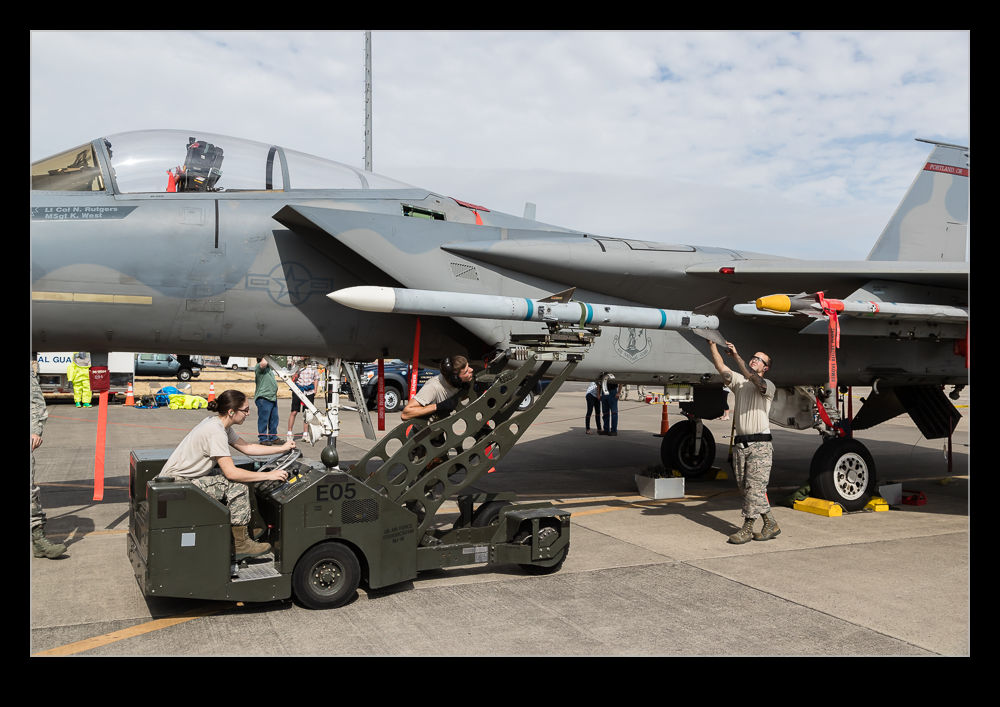 The missile configuration was quite a mix. They had six AMRAAMS to load, four on the fuselage and two on the stub pylons. The other two stubs were fitted with an AIM-9M and an AIM-9X. The Sidewinders were loaded by hand but the AMRAAMs are heavier and required the use of a mechanical loader. Prepping the plane before the missiles came close took a while and then the missiles were loaded in sequence with things like fins being added at different times such that some were on before the missile was attached and some were added once it was installed.
The missile configuration was quite a mix. They had six AMRAAMS to load, four on the fuselage and two on the stub pylons. The other two stubs were fitted with an AIM-9M and an AIM-9X. The Sidewinders were loaded by hand but the AMRAAMs are heavier and required the use of a mechanical loader. Prepping the plane before the missiles came close took a while and then the missiles were loaded in sequence with things like fins being added at different times such that some were on before the missile was attached and some were added once it was installed.
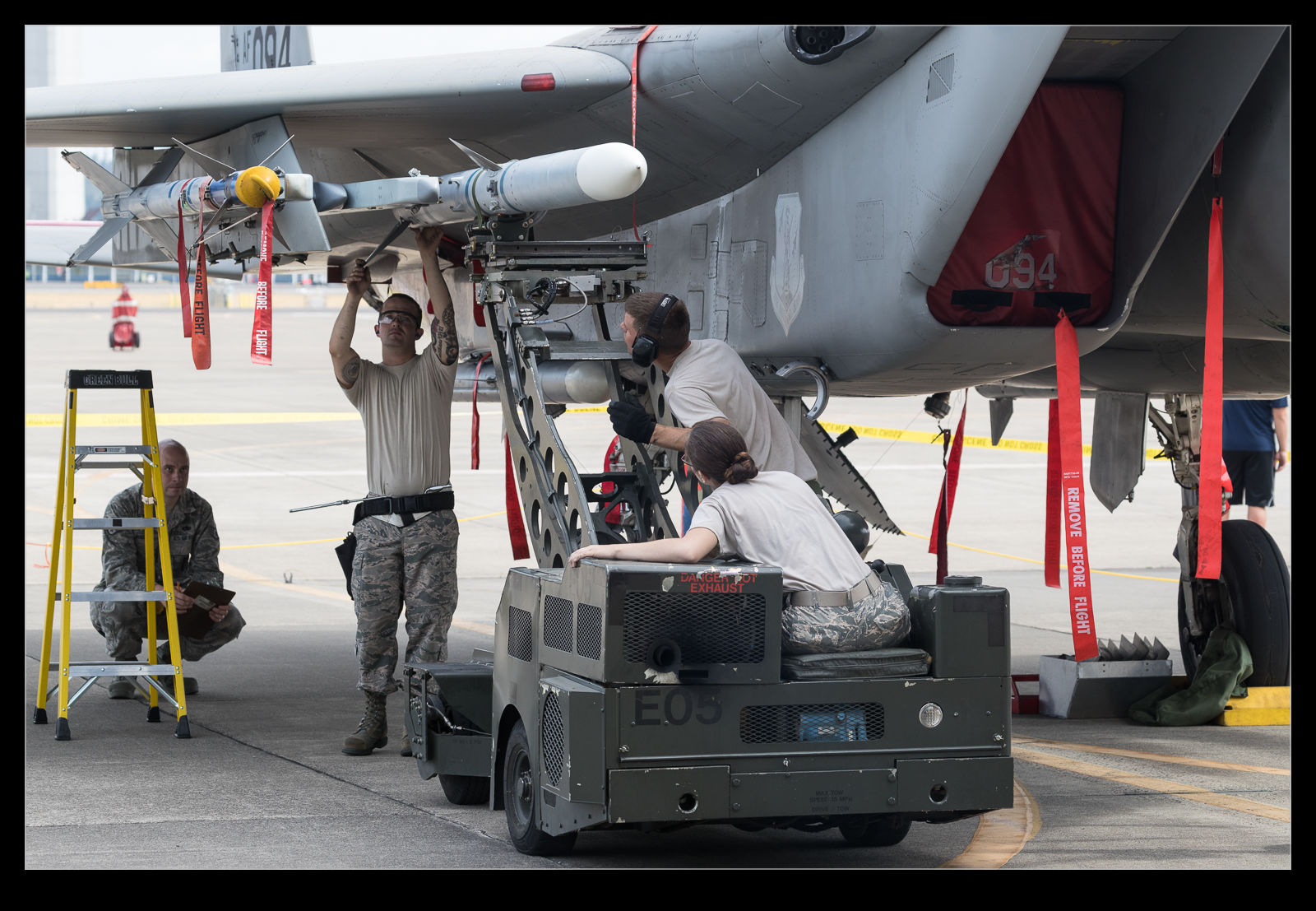 Once the whole task was completed, they reversed the process and removed the missiles. There was some choreography involved with getting the loader in place. It is not a subtle piece of machinery, but it could be placed quite accurately. Then there is adjustability in the rotation and position of the missile holders to allow things to be fine-tuned into position. Maneuvering a missile on to the rail or the launcher while not hitting anything else also requires some careful work. It was a most interesting process to watch.
Once the whole task was completed, they reversed the process and removed the missiles. There was some choreography involved with getting the loader in place. It is not a subtle piece of machinery, but it could be placed quite accurately. Then there is adjustability in the rotation and position of the missile holders to allow things to be fine-tuned into position. Maneuvering a missile on to the rail or the launcher while not hitting anything else also requires some careful work. It was a most interesting process to watch.
It is Dark at Nellis During the Night Launch
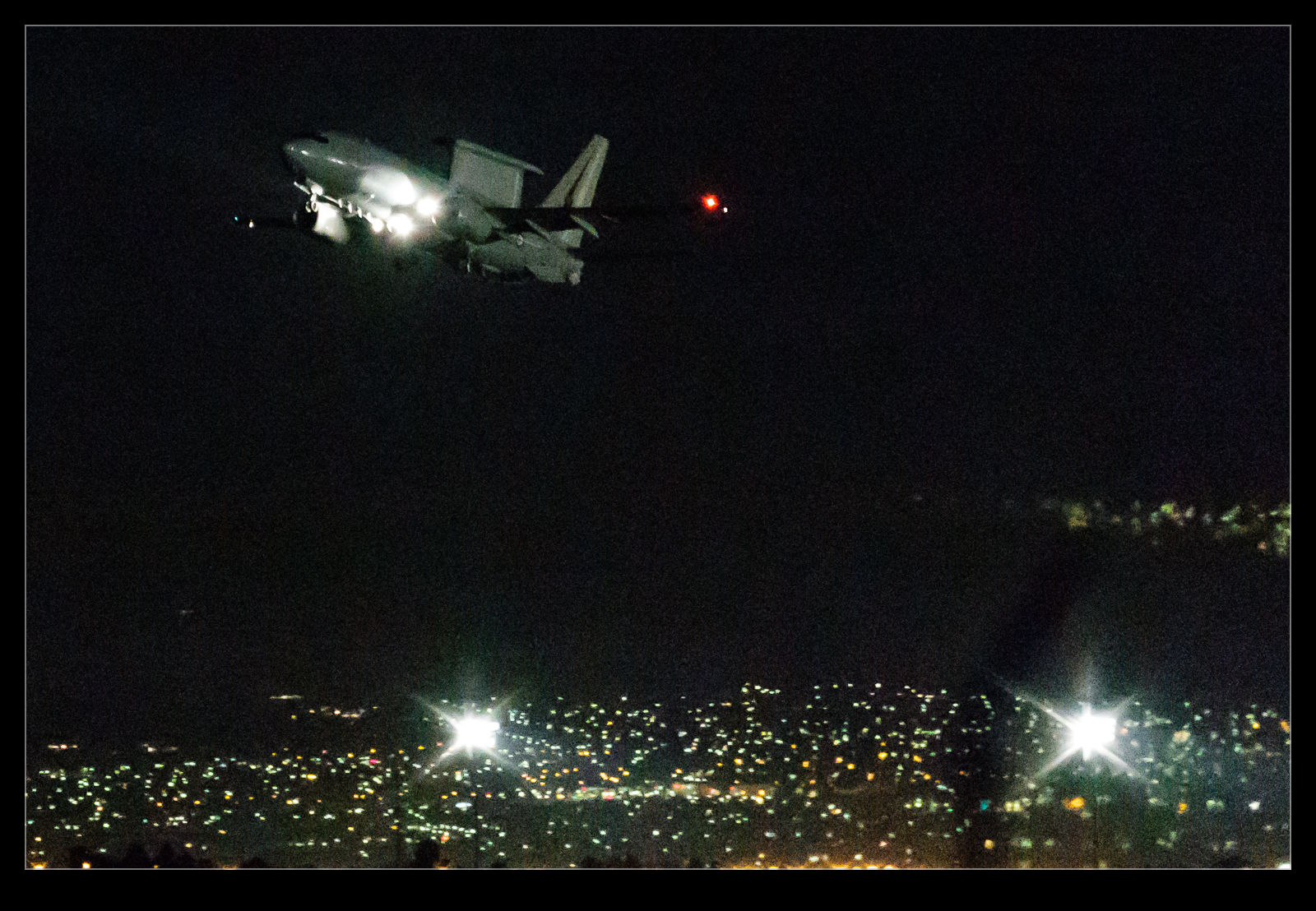 On previous trips to Red Flag I have taken pictures of the departing B-1Bs as they fly overhead. The burners are really impressive and definitely worth getting a shot of from below. However, having done this a few times, I wanted to try something different. The fighter get out of burner very quickly after they get airborne. They are in mil power for ages before they get to you on the centerline. I wanted to see what you could get from the side a lot closer in so Paul agreed to try something different.
On previous trips to Red Flag I have taken pictures of the departing B-1Bs as they fly overhead. The burners are really impressive and definitely worth getting a shot of from below. However, having done this a few times, I wanted to try something different. The fighter get out of burner very quickly after they get airborne. They are in mil power for ages before they get to you on the centerline. I wanted to see what you could get from the side a lot closer in so Paul agreed to try something different.
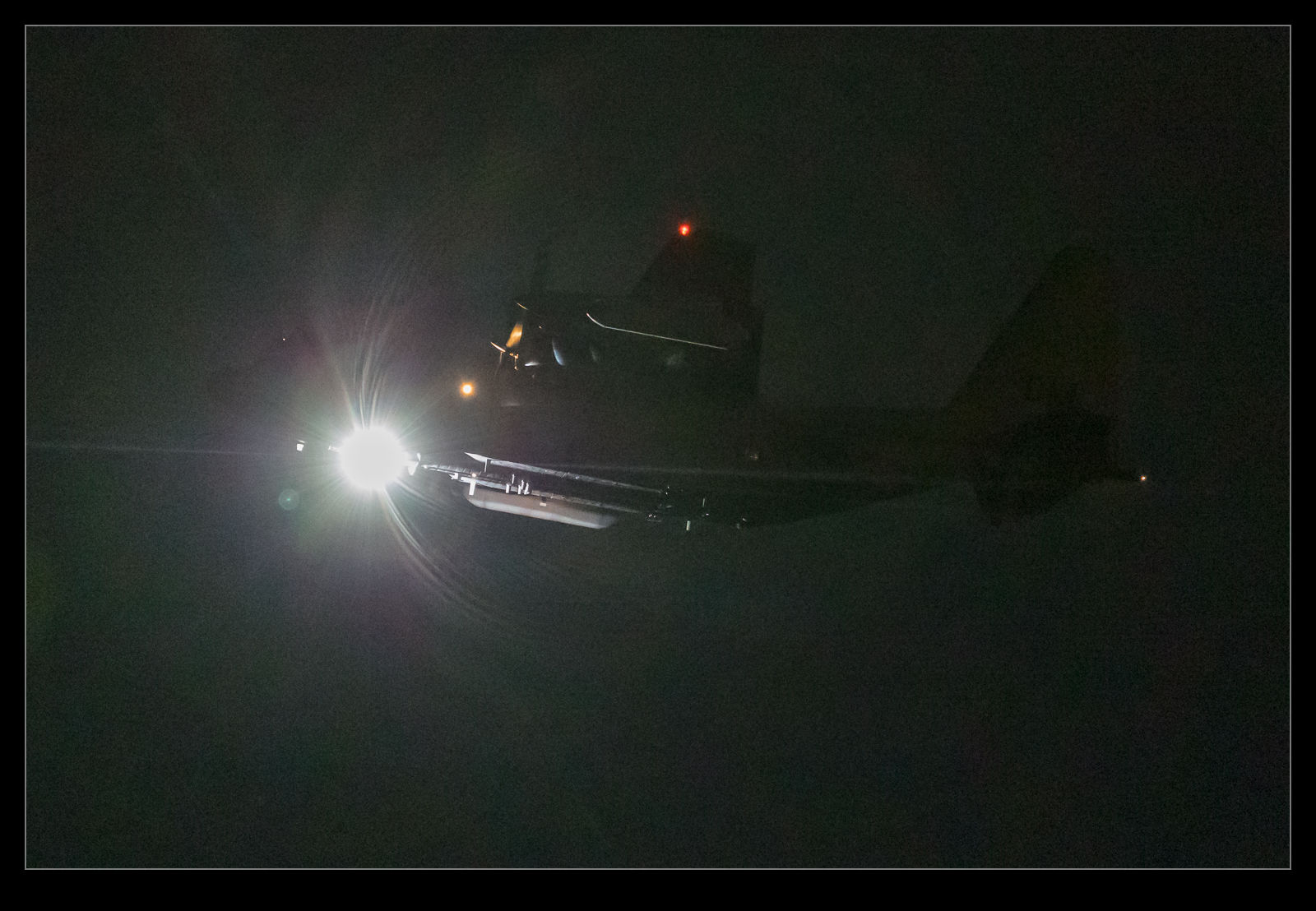 We ended up shooting a lot of side on stuff of departures for the night launch. Unfortunately, we didn’t appreciate just how dark it is at Nellis at night. We had a good moon so we were hopeful that there might be some residual light. It turns out that this is not the case. Even close in, the fighters are out of burner. The tankers and the E-7 went out and I got some shots but they were a struggle, event making use of the best high ISO capabilities of the cameras. The B-1s did show up okay but I still didn’t do as well as I thought I should have.
We ended up shooting a lot of side on stuff of departures for the night launch. Unfortunately, we didn’t appreciate just how dark it is at Nellis at night. We had a good moon so we were hopeful that there might be some residual light. It turns out that this is not the case. Even close in, the fighters are out of burner. The tankers and the E-7 went out and I got some shots but they were a struggle, event making use of the best high ISO capabilities of the cameras. The B-1s did show up okay but I still didn’t do as well as I thought I should have.
 I learned a bit about the performance of the cameras. I was shooting at super high ISO settings with the camera wide open. However, as I review the shots, I realize the camera was behaving in a way that I had not anticipated. I was shooting in aperture priority with some negative exposure compensation dialed in. As I look through the shots I see that the camera would start out with a dark shot, gradually boost the exposure and then go dark again. I would review the shots and see one that was looking good but know that the next would be dark.
I learned a bit about the performance of the cameras. I was shooting at super high ISO settings with the camera wide open. However, as I review the shots, I realize the camera was behaving in a way that I had not anticipated. I was shooting in aperture priority with some negative exposure compensation dialed in. As I look through the shots I see that the camera would start out with a dark shot, gradually boost the exposure and then go dark again. I would review the shots and see one that was looking good but know that the next would be dark.
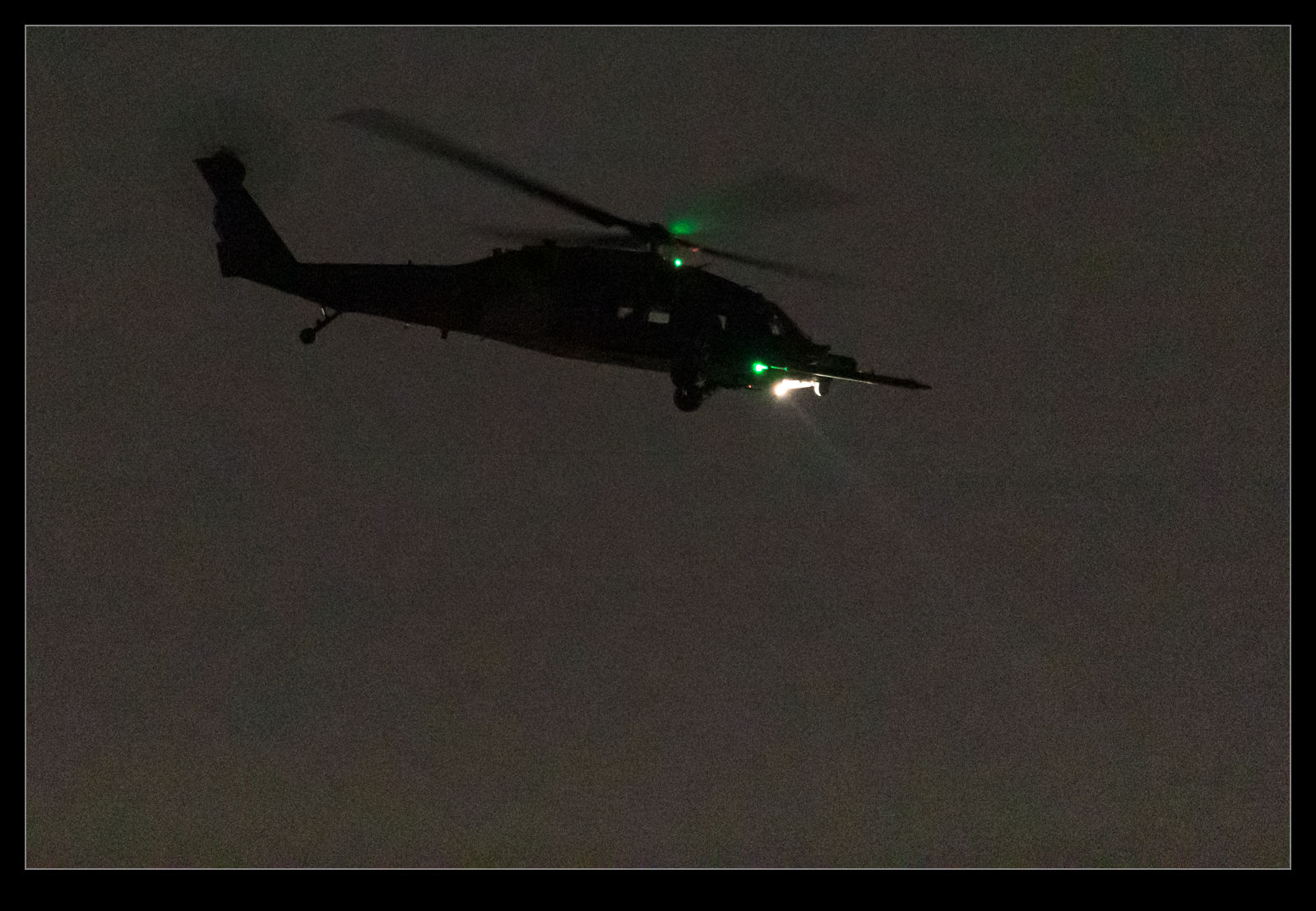 When shooting in such limited light, the shutter speeds are very low and the number of lost shots is high. Therefore, you can’t afford to have the exposure be bad. I don’t know how many shots I lost since they may not have been sharp anyway but I cut down on my opportunities. In future, I need to have all of the exposures be acceptable in order to maximize my opportunities. Therefore, I think I shall have to go fully manual on everything for these shots. Set ISO up high and then go to manual aperture and shutter speed. I will still lose a lot of shots but at least I can focus on dealing with my handholding technique rather than worrying about how the camera is metering a dark night. It’s not too reasonable to expect the camera to get that right every time. It is a pretty extreme case!
When shooting in such limited light, the shutter speeds are very low and the number of lost shots is high. Therefore, you can’t afford to have the exposure be bad. I don’t know how many shots I lost since they may not have been sharp anyway but I cut down on my opportunities. In future, I need to have all of the exposures be acceptable in order to maximize my opportunities. Therefore, I think I shall have to go fully manual on everything for these shots. Set ISO up high and then go to manual aperture and shutter speed. I will still lose a lot of shots but at least I can focus on dealing with my handholding technique rather than worrying about how the camera is metering a dark night. It’s not too reasonable to expect the camera to get that right every time. It is a pretty extreme case!
The Lonely Life of the AWACS
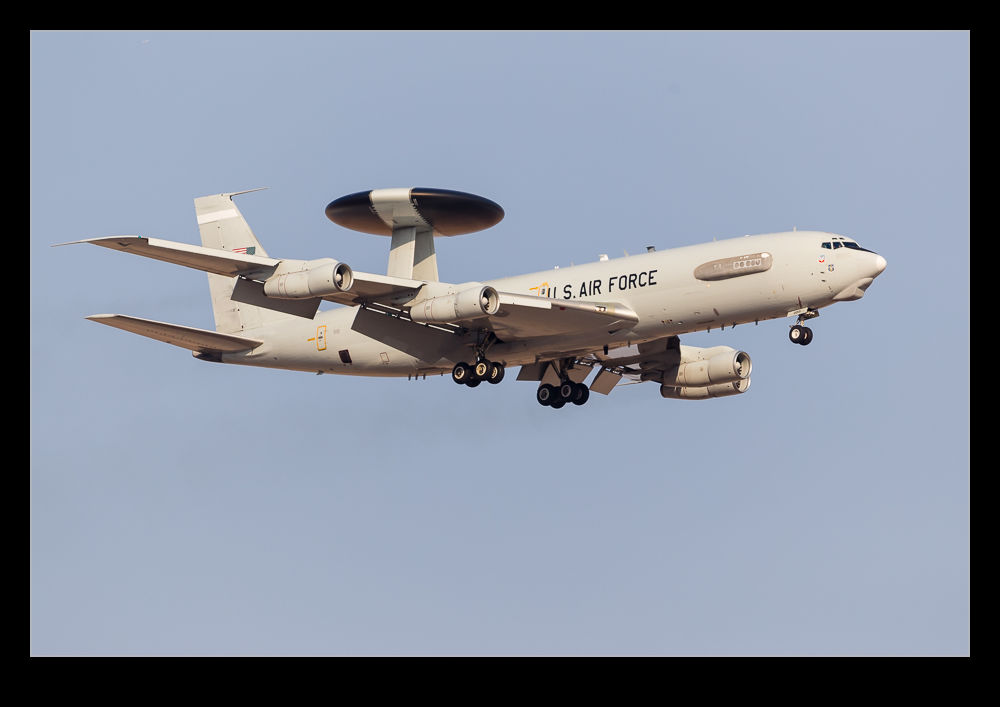 The beginning and end of an exercise has a common theme. Long before the fighter start launching, an E-3 AWACS will lumber off the runway and head out towards the exercise area. It gets on station and sets up to direct the fight as the fast movers enter the range. It will support the whole mission and will guide the small guys back home at the conclusion of their missions. It will deal with any of the jets that have to change plans or abort. With everyone else back on the ground, the AWACS can finally come home. They are often the last jet back on the ground. Hopefully everyone outside will stay around for their recovery. You wouldn’t want them to feel neglected!
The beginning and end of an exercise has a common theme. Long before the fighter start launching, an E-3 AWACS will lumber off the runway and head out towards the exercise area. It gets on station and sets up to direct the fight as the fast movers enter the range. It will support the whole mission and will guide the small guys back home at the conclusion of their missions. It will deal with any of the jets that have to change plans or abort. With everyone else back on the ground, the AWACS can finally come home. They are often the last jet back on the ground. Hopefully everyone outside will stay around for their recovery. You wouldn’t want them to feel neglected!
Spanish Fake Canopies
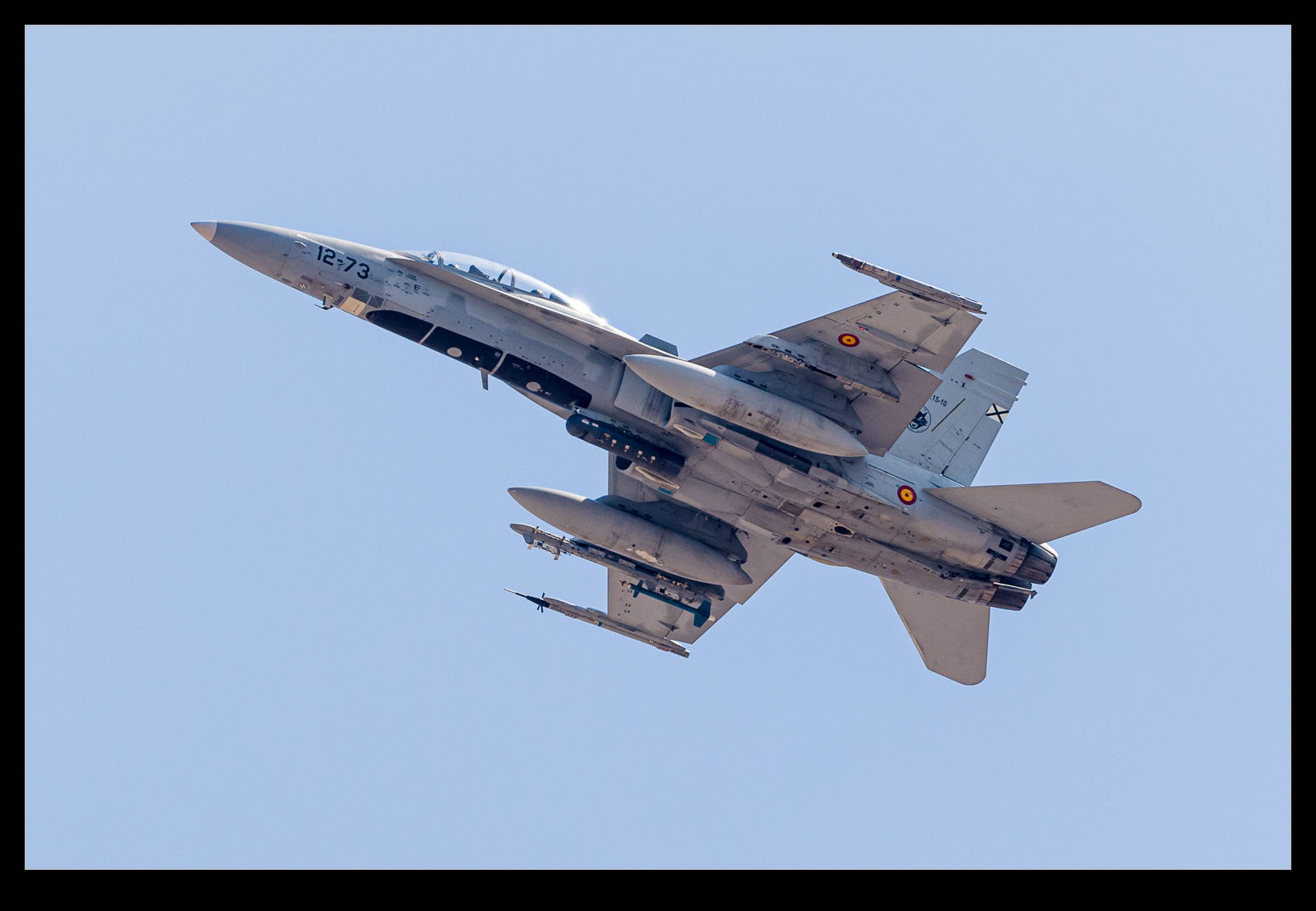 When the Canadian Hornets first came into service, they introduced the fake canopy on the underside of the front fuselage. This was a painted outline of the canopy. The idea was that, on the heat of a dogfight, the opposing pilot might be confused about the orientation of the jet and think it was coming towards him rather than away as a result of seeing this canopy.
When the Canadian Hornets first came into service, they introduced the fake canopy on the underside of the front fuselage. This was a painted outline of the canopy. The idea was that, on the heat of a dogfight, the opposing pilot might be confused about the orientation of the jet and think it was coming towards him rather than away as a result of seeing this canopy.
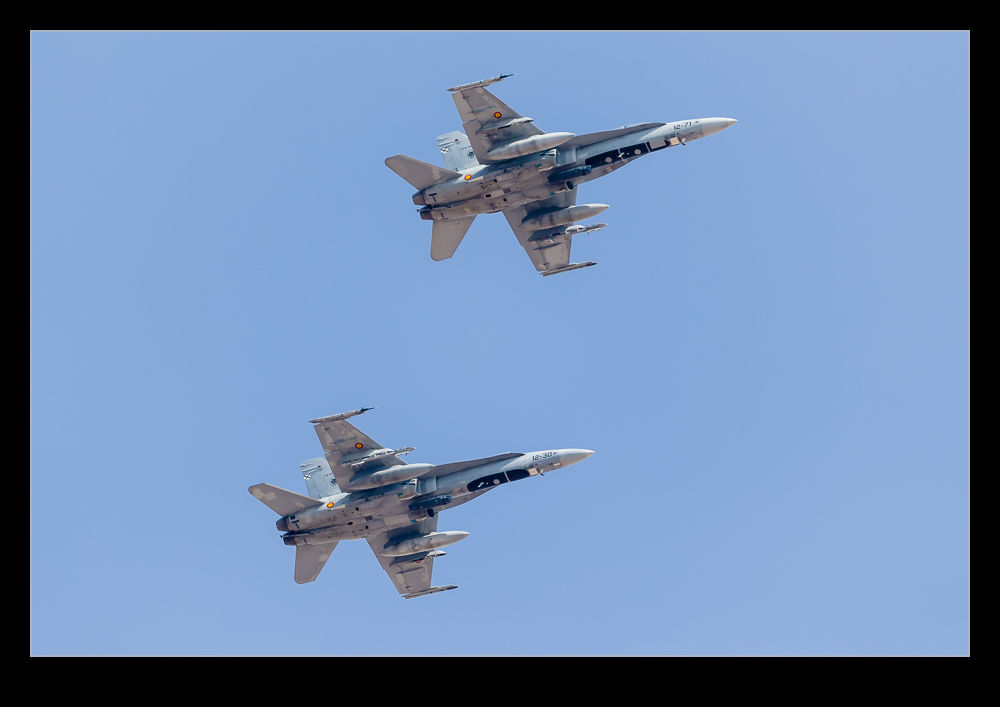 The US Hornets never had this on the fleet jets but it appears that the Spanish Air Force has adopted it for theirs (although not all of the jets are so painted). I heard a rumor that the Canadians have some rights on this and other users have to pay for it but I have no idea whether there is any truth to this or not. However, their jets certainly do have the canopies painted on the fuselage.
The US Hornets never had this on the fleet jets but it appears that the Spanish Air Force has adopted it for theirs (although not all of the jets are so painted). I heard a rumor that the Canadians have some rights on this and other users have to pay for it but I have no idea whether there is any truth to this or not. However, their jets certainly do have the canopies painted on the fuselage.
Sweating on the Range
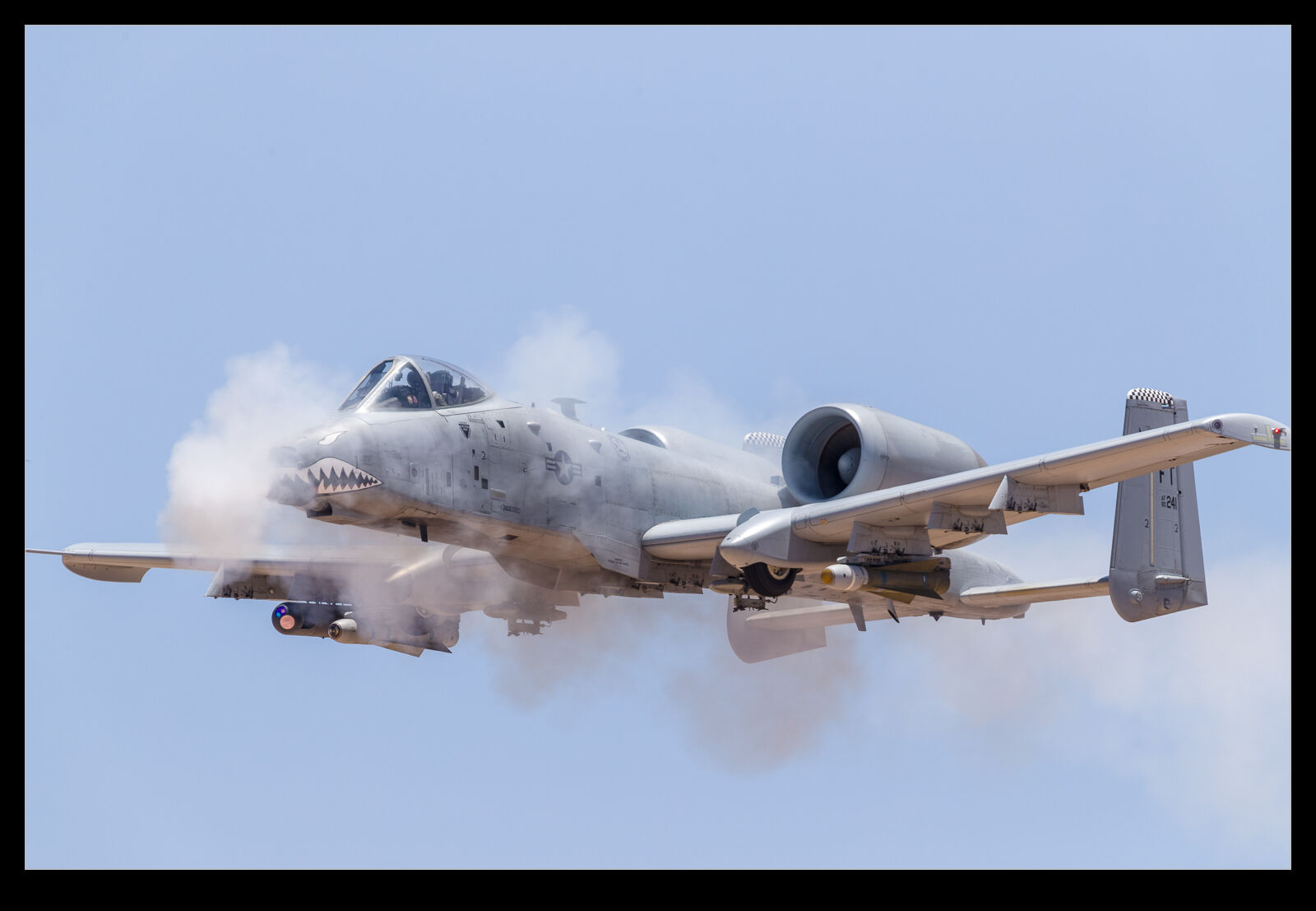 While watching the arrivals for Hawgsmoke was a lot of fun, the main focus was the range work on the first day of exercise. The Air Force put us on a bus for the drive out to the Barry M Goldwater Range south of Gila Bend. This is about a two hour drive. The temperatures were above 100F and the bus was a bit lacking in air conditioning terms. We were toasty as we traveled out. Standing on the range is another thing. It is rather warm standing out in the sun. However, you soon forget how hot it is when the jets arrive.
While watching the arrivals for Hawgsmoke was a lot of fun, the main focus was the range work on the first day of exercise. The Air Force put us on a bus for the drive out to the Barry M Goldwater Range south of Gila Bend. This is about a two hour drive. The temperatures were above 100F and the bus was a bit lacking in air conditioning terms. We were toasty as we traveled out. Standing on the range is another thing. It is rather warm standing out in the sun. However, you soon forget how hot it is when the jets arrive.
 The four ships for each unit have a range slot. They start with the various bomb missions so they are quite a way off while this is underway. You can just see the little practice bombs as they are released if you look closely and then the impact on the target out on the range. They try a few different profiles. Then they move on to the strafe work.
The four ships for each unit have a range slot. They start with the various bomb missions so they are quite a way off while this is underway. You can just see the little practice bombs as they are released if you look closely and then the impact on the target out on the range. They try a few different profiles. Then they move on to the strafe work.
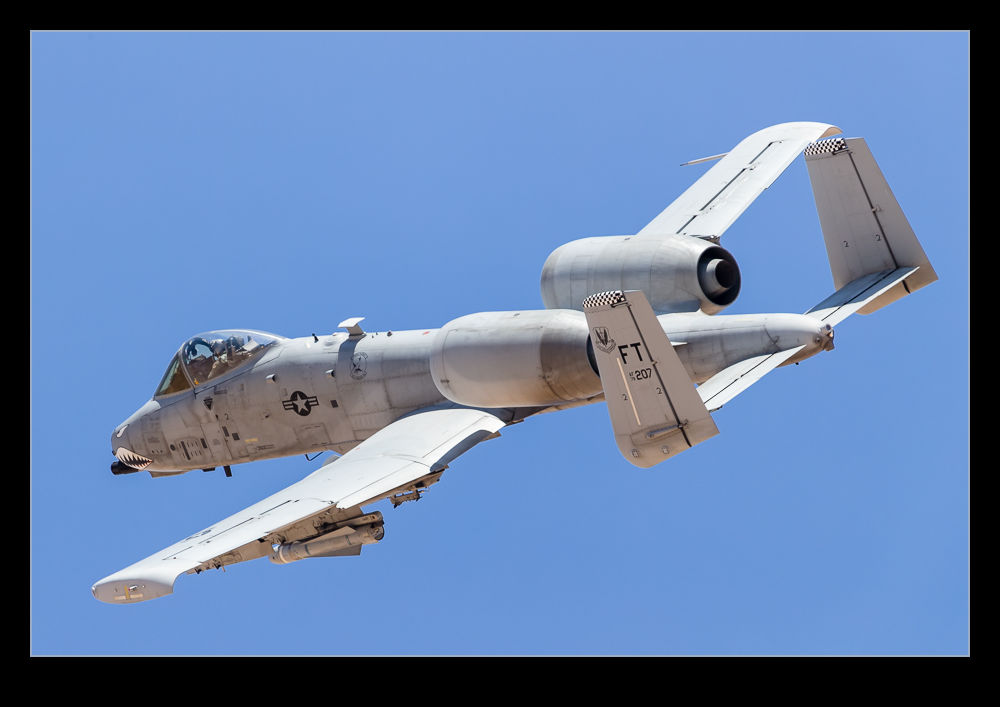 Long range strafe is first with the jets firing from quite a way out from the target. They then move on to low angle strafe where they are firing from very close to our location on the range tower often firing until alongside us. The first experience of the A-10 firing is quite something and it is good to see someone react to their first shoot. After the firing pass, the jets turn overhead our location so you get a great topside view of the jets.
Long range strafe is first with the jets firing from quite a way out from the target. They then move on to low angle strafe where they are firing from very close to our location on the range tower often firing until alongside us. The first experience of the A-10 firing is quite something and it is good to see someone react to their first shoot. After the firing pass, the jets turn overhead our location so you get a great topside view of the jets.
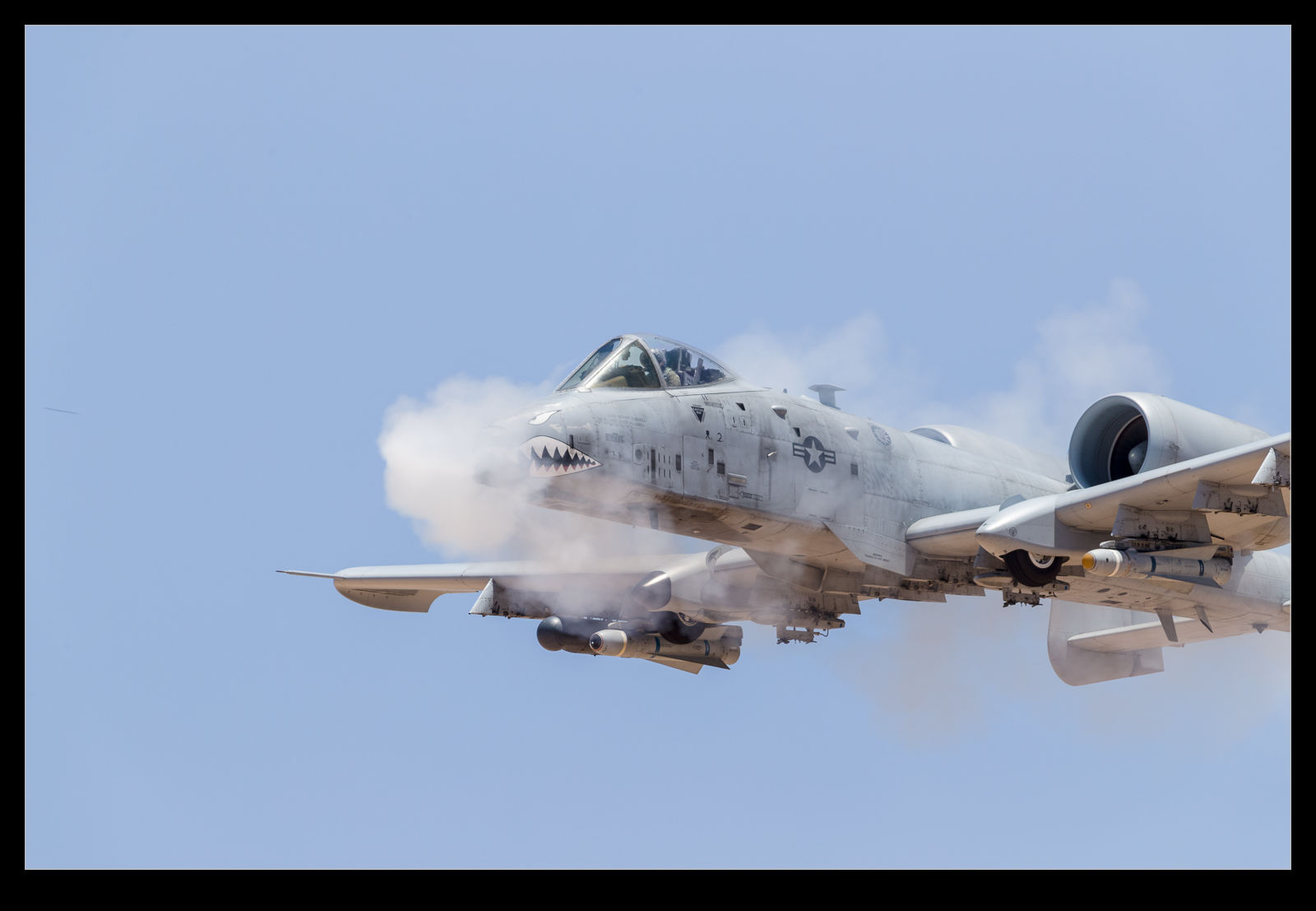 With the different units taking their turns on the range, you can get shots from different perspectives. Close in shots, wider shots, a bit of video – all of this can be done in the available time. Sadly, we have to head off again before too long and it is back on the bus for the return journey. I spent the day drinking a ton of water. The bus was hot, the range was hot and the bus was hot again so I needed every drop I drank. The shower when I got back to the hotel was definitely welcome. I wouldn’t hold this against the visit though. It is a ton of fun and the time is spent with some good people too so you can’t go wrong.
With the different units taking their turns on the range, you can get shots from different perspectives. Close in shots, wider shots, a bit of video – all of this can be done in the available time. Sadly, we have to head off again before too long and it is back on the bus for the return journey. I spent the day drinking a ton of water. The bus was hot, the range was hot and the bus was hot again so I needed every drop I drank. The shower when I got back to the hotel was definitely welcome. I wouldn’t hold this against the visit though. It is a ton of fun and the time is spent with some good people too so you can’t go wrong.
- A USAF A-10 Thunderbolt II fires its 30mm gun at a strafe target on the Barry M Goldwater Range near Gila Bend Arizona.
- A USAF A-10 Thunderbolt II fires its 30mm gun at a strafe target on the Barry M Goldwater Range near Gila Bend Arizona.
- A USAF A-10 Thunderbolt II fires its 30mm gun at a strafe target on the Barry M Goldwater Range near Gila Bend Arizona.
Hawgsmoke on the Ramp
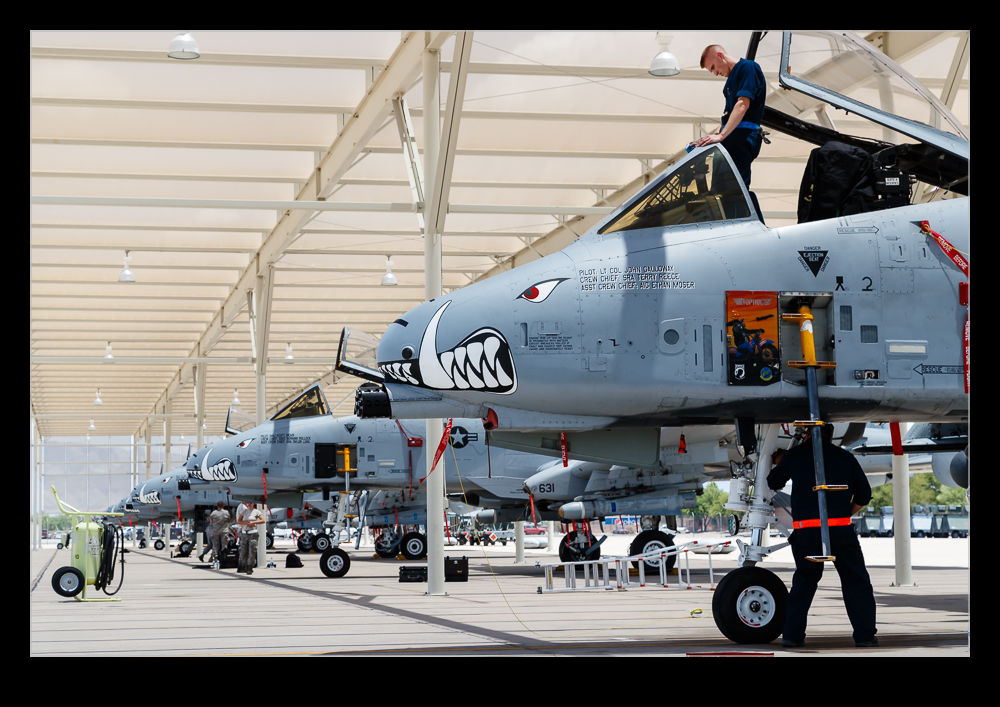 Every two years the A-10 community gets together for the Hawgsmoke competition. I covered it again for GAR and you can see the piece I wrote here. The first day we were there was the arrival day. The plan had been to watch some landings and then to move to the parking ramp area. As it happened, we couldn’t get too close to the runway and some of the arrivals were delayed so we headed to the ramp instead which proved to be a good choice. The A-10s were coming in from the various units.
Every two years the A-10 community gets together for the Hawgsmoke competition. I covered it again for GAR and you can see the piece I wrote here. The first day we were there was the arrival day. The plan had been to watch some landings and then to move to the parking ramp area. As it happened, we couldn’t get too close to the runway and some of the arrivals were delayed so we headed to the ramp instead which proved to be a good choice. The A-10s were coming in from the various units.
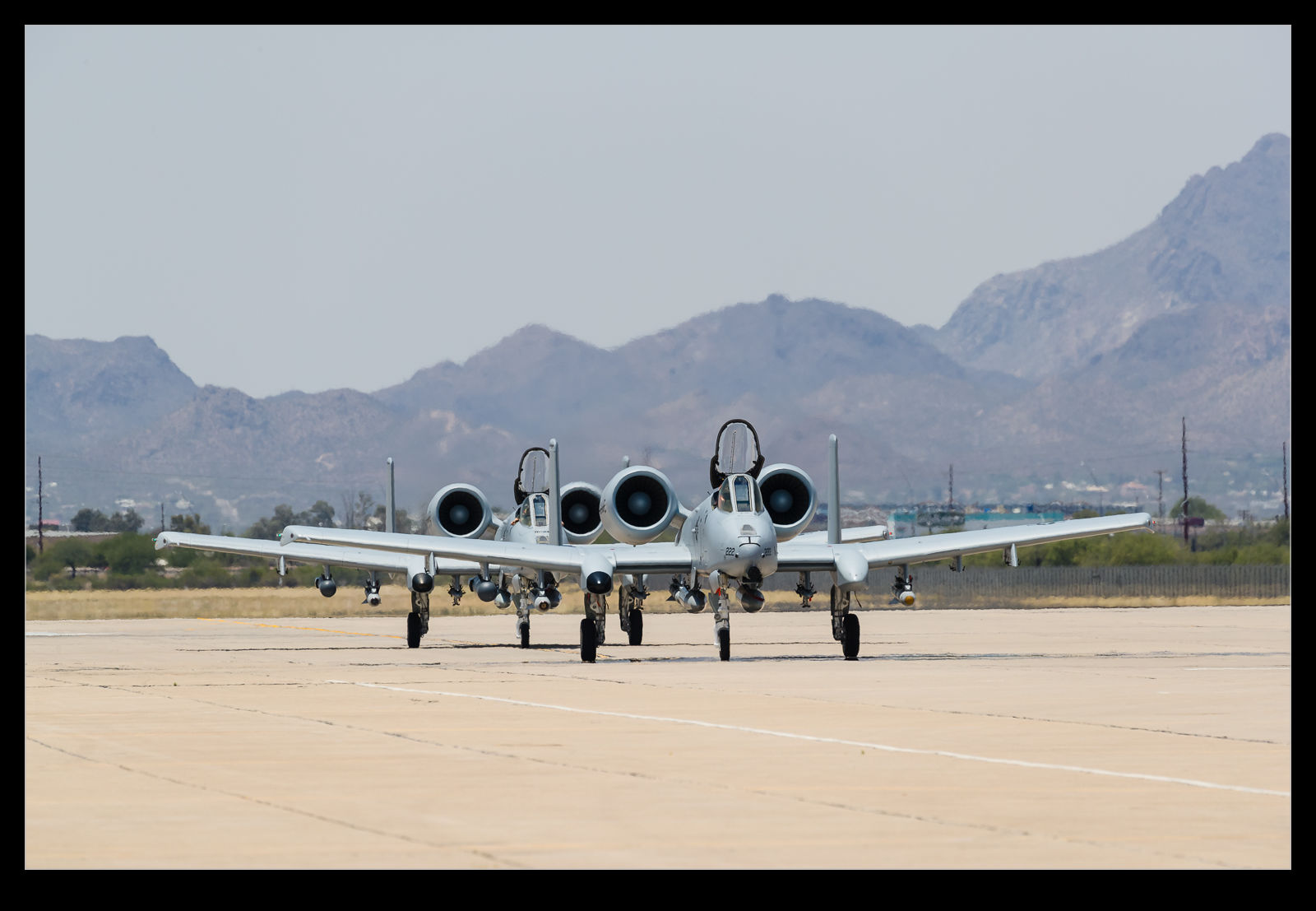 Initially he team were a little concerned about how we could access the area while the jets were on the move but we gradually got more access as they got more confident in us staying in the right places. The jets were taxiing along the outsides and then parking facing inwards. Consequently, we could be in between the rows and out of the way of the aircraft on the move. As more jets were parked up, we could move further out towards to the taxiway and closer to the arriving aircraft. It all worked pretty well.
Initially he team were a little concerned about how we could access the area while the jets were on the move but we gradually got more access as they got more confident in us staying in the right places. The jets were taxiing along the outsides and then parking facing inwards. Consequently, we could be in between the rows and out of the way of the aircraft on the move. As more jets were parked up, we could move further out towards to the taxiway and closer to the arriving aircraft. It all worked pretty well.
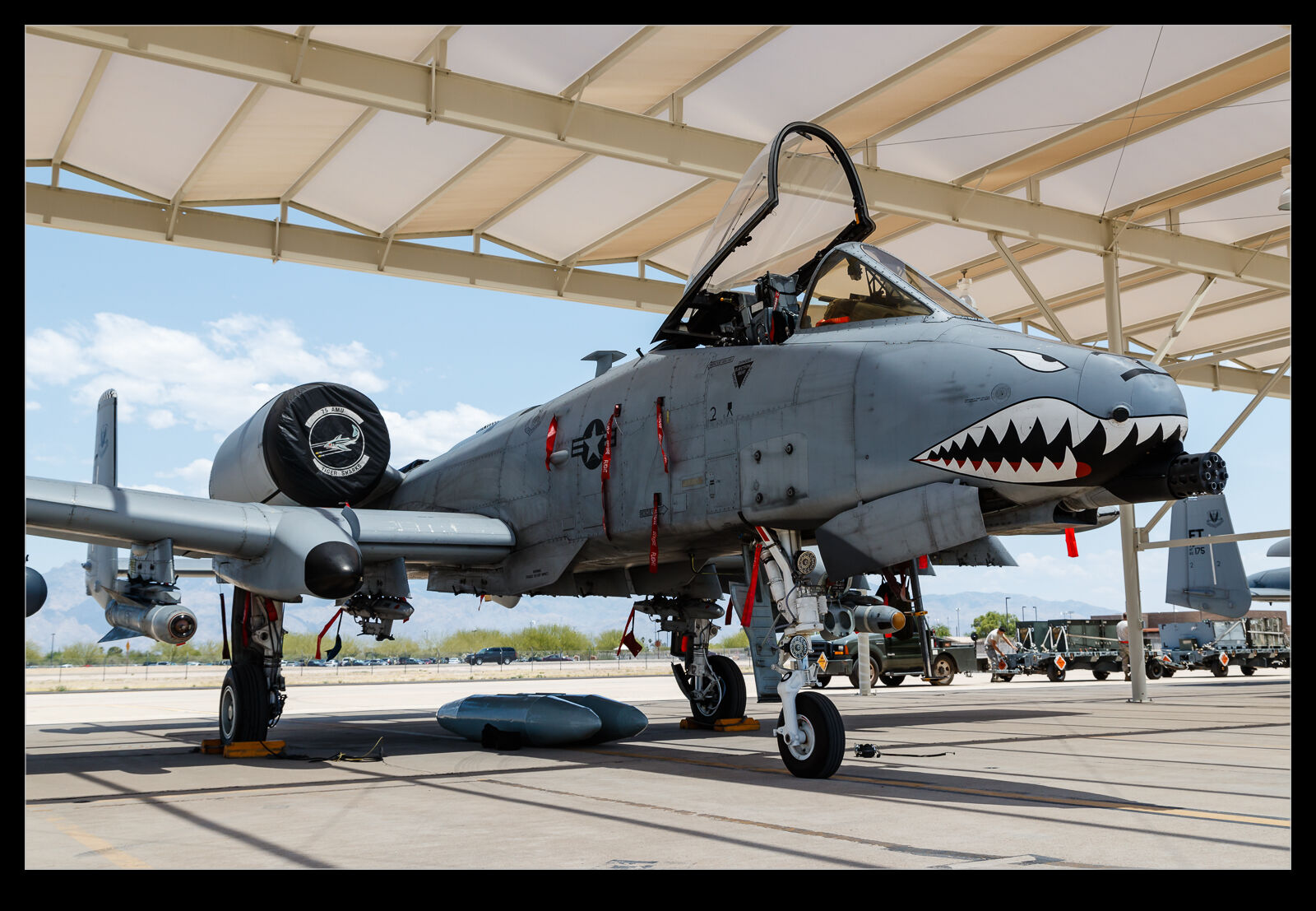 Once the jets were on the ground the ground crews were straight into action taking off he baggage pods and starting to load up with practice bombs ready for the range slots that were to come as the exercise got underway. Most of the jets were parked outside the sun shelters so the crews were getting pretty hot as they worked. Plenty of coolers of water were on hand to keep them in good shape. This was a good start to the coverage of the exercise from my perspective.
Once the jets were on the ground the ground crews were straight into action taking off he baggage pods and starting to load up with practice bombs ready for the range slots that were to come as the exercise got underway. Most of the jets were parked outside the sun shelters so the crews were getting pretty hot as they worked. Plenty of coolers of water were on hand to keep them in good shape. This was a good start to the coverage of the exercise from my perspective.
- USAF A-10 Thunderbolt II aircraft on the ramp at Davis Monthan AFZ in Tucson Arizona taking part in the Hawgsmoke exercise.
- A USAF A-10 Thunderbolt II parked on the ramp at Davis Monthan AFB in Tucson Arizona preparing for Hawgsmoke 2016.
Red Flag Night Launch
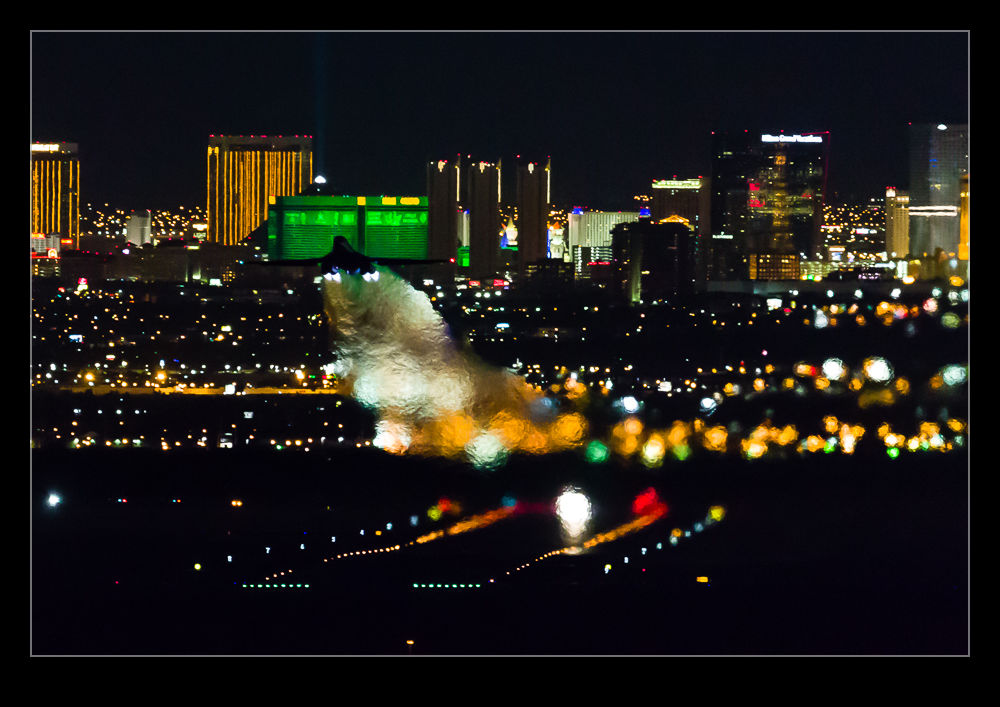 This is an example of what worked and what might have been. After night fell at Red Flag, we headed up to the far end of the base where you are looking down towards the runways and the city of Las Vegas is in the background. Here the jets are departing over your head for the night mission. Most of them are sufficiently high and fast to cancel afterburner before they reach you. However, the B-1s stay in burner for a lot longer. Getting a shot of them in the dark – or more accurately, a shot of their engine exhausts – was the aim o the game.
This is an example of what worked and what might have been. After night fell at Red Flag, we headed up to the far end of the base where you are looking down towards the runways and the city of Las Vegas is in the background. Here the jets are departing over your head for the night mission. Most of them are sufficiently high and fast to cancel afterburner before they reach you. However, the B-1s stay in burner for a lot longer. Getting a shot of them in the dark – or more accurately, a shot of their engine exhausts – was the aim o the game.
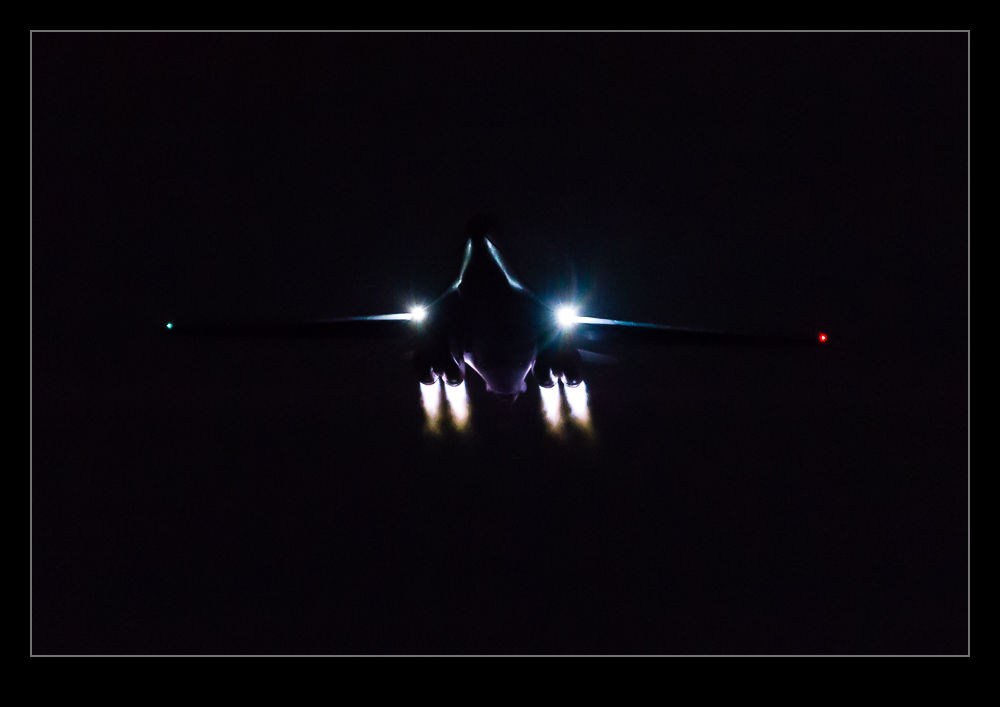 They really look very cool as they blast off the runway and head towards you. It is pretty dark so you have the lenses wide open and the ISO cranked up very high. Even then, the shutter speed is low so it is a bit hit or miss. I did get a few that came out pretty nicely. Meanwhile, I had been trying to get a series of shots with a second camera to make into a time-lapse. Unfortunately, I hadn’t brought a cable release with me. I was trying to bodge together something to keep the shutter depressed. It would work for a while and then I would have to try again. The result of this is that I was progressively moving the camera. No tripod for this effort. It was resting on the roof of the car! The resulting time lapse is shorter than I would like and obviously not very good but I include it below just so you can see what I was trying for. Another time perhaps. Meanwhile, the following week, Chris went back and had a better planned go. I think his results were far better.
They really look very cool as they blast off the runway and head towards you. It is pretty dark so you have the lenses wide open and the ISO cranked up very high. Even then, the shutter speed is low so it is a bit hit or miss. I did get a few that came out pretty nicely. Meanwhile, I had been trying to get a series of shots with a second camera to make into a time-lapse. Unfortunately, I hadn’t brought a cable release with me. I was trying to bodge together something to keep the shutter depressed. It would work for a while and then I would have to try again. The result of this is that I was progressively moving the camera. No tripod for this effort. It was resting on the roof of the car! The resulting time lapse is shorter than I would like and obviously not very good but I include it below just so you can see what I was trying for. Another time perhaps. Meanwhile, the following week, Chris went back and had a better planned go. I think his results were far better.
Air-to-Air With Some Raptors
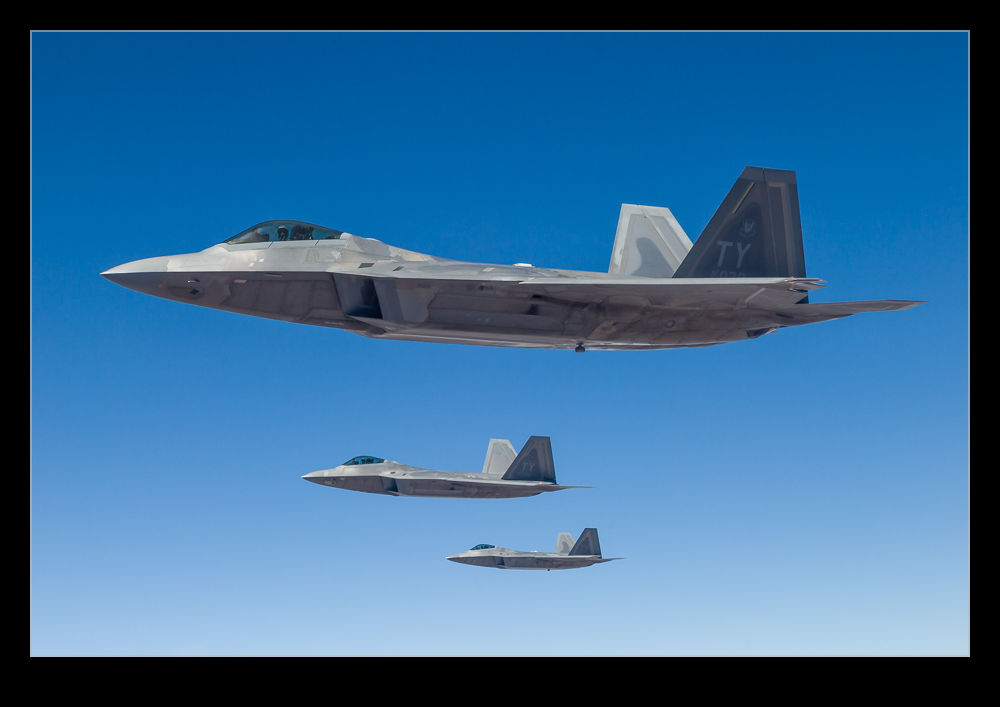 Day two of my Red Flag visit was to involve a trip in one o the KC-135 tankers supporting the exercise. After the troubles of the previous day, it wasn’t entirely clear whether it would go ahead but we turned up at the allotted time and were escorted to the tanker ramp area. A few confused conversations took place with our escort and the crews but it all got worked out and we were briefed on the flight. We were the Blue tanker and were supposed to be refueling F-22s and F-16s, supposedly from Aviano with the Shaw F-16s (which are almost always out of bounds for photography) supposedly going to the Red tanker.
Day two of my Red Flag visit was to involve a trip in one o the KC-135 tankers supporting the exercise. After the troubles of the previous day, it wasn’t entirely clear whether it would go ahead but we turned up at the allotted time and were escorted to the tanker ramp area. A few confused conversations took place with our escort and the crews but it all got worked out and we were briefed on the flight. We were the Blue tanker and were supposed to be refueling F-22s and F-16s, supposedly from Aviano with the Shaw F-16s (which are almost always out of bounds for photography) supposedly going to the Red tanker.
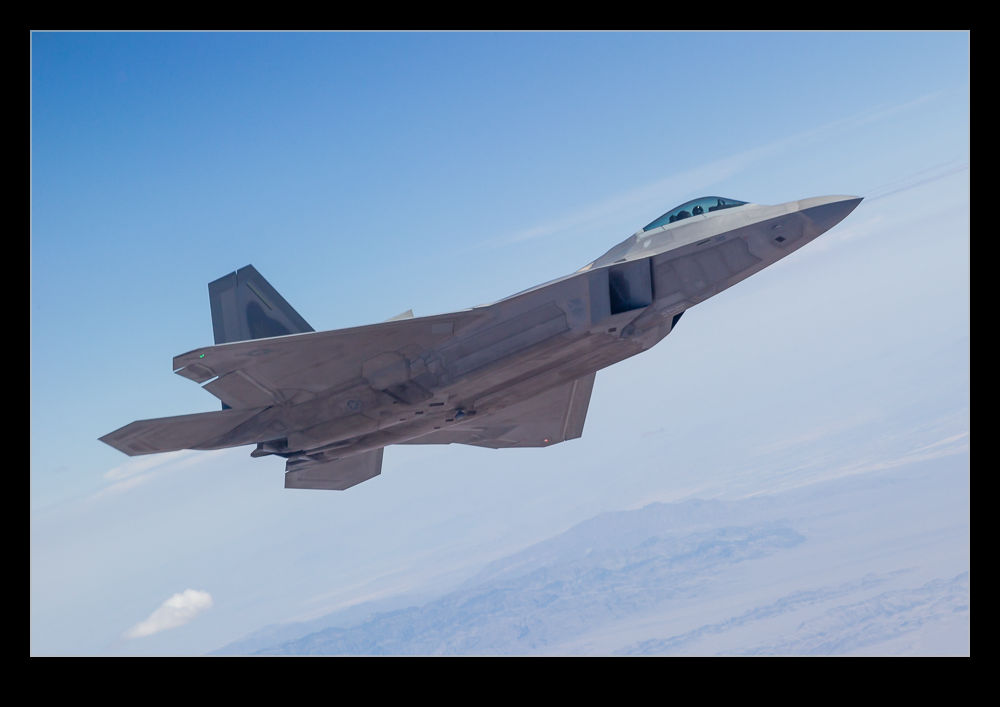 We waited in the ops building for as long as possible before heading out. It was very hot on the ramp but even hotter in the jet. KC-135s do not have any air conditioning while parked on the ground and are painted dark grey. Consequently, the back of the hold (where we would be) is about as hot a place as I have ever experienced. We got there and it was time to sit very still and wait. Also, rationing the water was a good idea since we would be flying for about three hours.
We waited in the ops building for as long as possible before heading out. It was very hot on the ramp but even hotter in the jet. KC-135s do not have any air conditioning while parked on the ground and are painted dark grey. Consequently, the back of the hold (where we would be) is about as hot a place as I have ever experienced. We got there and it was time to sit very still and wait. Also, rationing the water was a good idea since we would be flying for about three hours.
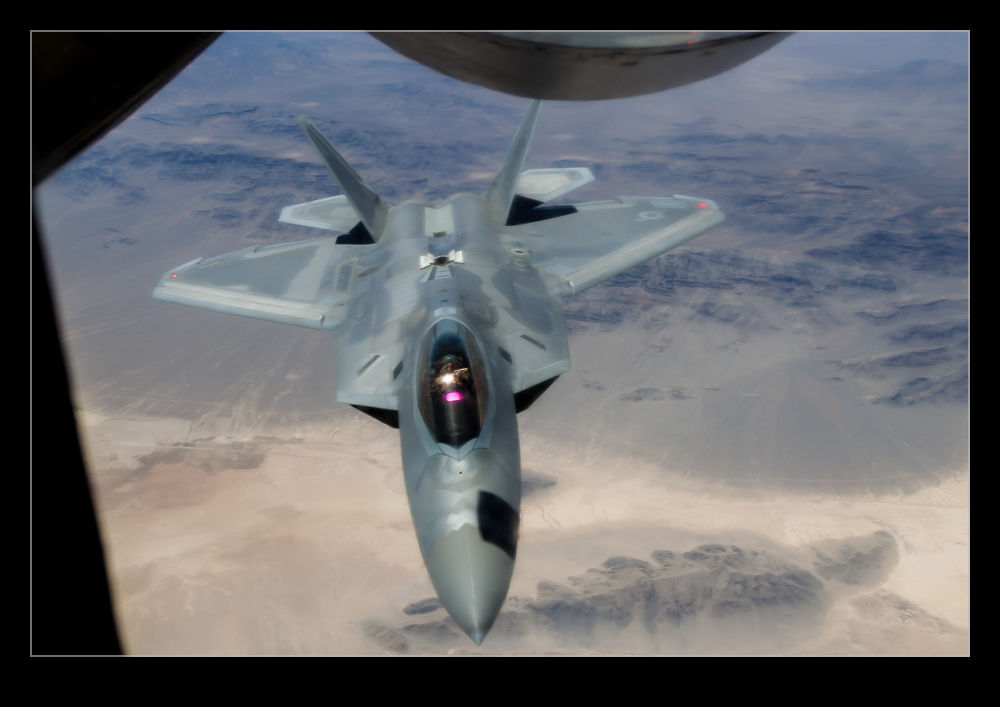 We taxied for takeoff and, once airborne, the cooling started to work and the temperature became reasonable. We agreed a rotation for everyone to get into the boomer’s position to get shots as the aircraft refueled. There are a couple of windows on each side of the jet too so we agreed to allow everyone get a chance with those too. Soon our first traffic appeared. A group of F-22s from Tyndall AFB came into view. Quite an impressive sight they make as they hang on the wing tip of the 135. They then take it in turns to drop under the jet and hook up to the boom before sliding out to the other side and waiting for the rest to finish. With some encouragement, they might make a more aggressive departure from the boom which is nice.
We taxied for takeoff and, once airborne, the cooling started to work and the temperature became reasonable. We agreed a rotation for everyone to get into the boomer’s position to get shots as the aircraft refueled. There are a couple of windows on each side of the jet too so we agreed to allow everyone get a chance with those too. Soon our first traffic appeared. A group of F-22s from Tyndall AFB came into view. Quite an impressive sight they make as they hang on the wing tip of the 135. They then take it in turns to drop under the jet and hook up to the boom before sliding out to the other side and waiting for the rest to finish. With some encouragement, they might make a more aggressive departure from the boom which is nice.
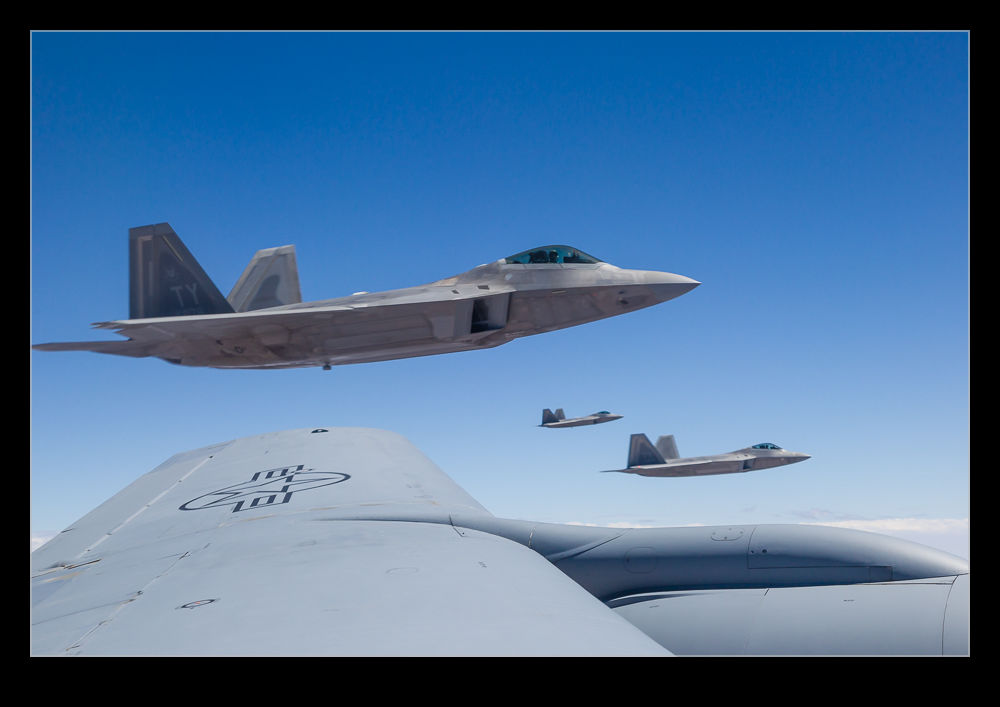 Our next traffic soon showed up. These were the F-16s but not from Aviano. They were Shaw jets and so out of bounds for photography. This was a big disappointment. We could take shots but they would be subject to scrutiny by the security team so would probably be deleted. I took a few but deleted them myself to speed the review process. They were cool to see even so. Lying beside the boomer and looking straight down into the cockpit of the jet below while the pilot looked up at us was an interesting experience.
Our next traffic soon showed up. These were the F-16s but not from Aviano. They were Shaw jets and so out of bounds for photography. This was a big disappointment. We could take shots but they would be subject to scrutiny by the security team so would probably be deleted. I took a few but deleted them myself to speed the review process. They were cool to see even so. Lying beside the boomer and looking straight down into the cockpit of the jet below while the pilot looked up at us was an interesting experience.
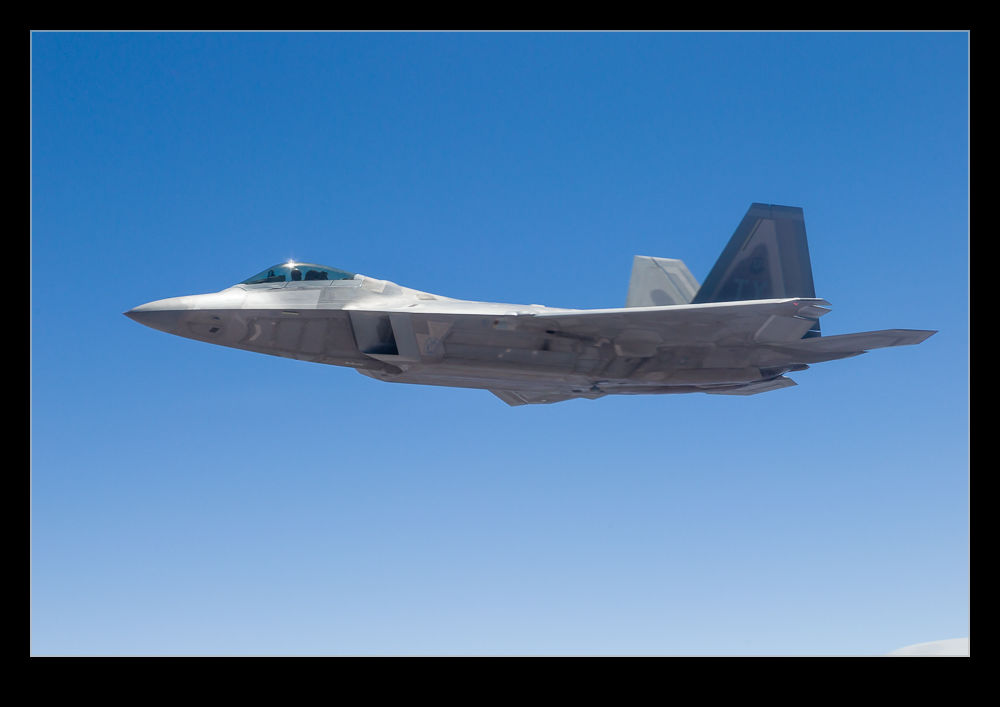 We had more F-22s while we were there but it didn’t seem that long before we were heading back down again. We strapped in for landing and then had an extra moment of interest as the aircraft had to carry out a go-around. There was a strong tailwind so, as we were looking like we would land long, a go-around was the safest bet. Once back on the ground, we handed in our cards for review. Waiting for them to be mailed back seemed like an eternal wait as I was keen to know whether I had got anything worthwhile. The summer sun was a bit harsh and there was a lot of fluid on the boomer’s window but I still ended up with a few that I am very happy with. Thanks to the team at Nellis AFB for making I work out.
We had more F-22s while we were there but it didn’t seem that long before we were heading back down again. We strapped in for landing and then had an extra moment of interest as the aircraft had to carry out a go-around. There was a strong tailwind so, as we were looking like we would land long, a go-around was the safest bet. Once back on the ground, we handed in our cards for review. Waiting for them to be mailed back seemed like an eternal wait as I was keen to know whether I had got anything worthwhile. The summer sun was a bit harsh and there was a lot of fluid on the boomer’s window but I still ended up with a few that I am very happy with. Thanks to the team at Nellis AFB for making I work out.

